mardi, 08 octobre 2013
R. Marchand: Reconquista
00:05 Publié dans Evénement, Livre, Livre | Lien permanent | Commentaires (0) | Tags : rené marchand, lyon, événement, france, livre, dédicace |  |
|  del.icio.us |
del.icio.us |  |
|  Digg |
Digg | ![]() Facebook
Facebook
L’Ecologie n’est pas la démagogie !

Pierre Le Vigan
Ex: http://metamag.fr
Les auteurs couplent cette idée avec celle d’un Revenu maximum acceptable (RMA), en d’autres termes d’un revenu maximum. Comme d’autres écologistes radicaux, ils fixent l’écart entre le revenu minimum universel (donc sans travailler) et le revenu maximum à 4. Les auteurs essaient aussi d’articuler leur projet de revenu inconditionnel d’autonomie avec une réduction du temps de travail qui permettrait un partage du travail. Ils ne sont là-dessus guère convaincants. On leur objectera volontiers qu’ils posent mal le problème qu’ils essaient de résoudre par leur « revenu universel ». D’une part le travail ne saurait être rejeté, il est le propre de l’homme. Un revenu sans travail est donc inacceptable. En défendant un tel revenu, ils se privent de tout moyen d’effectuer une critique solide de la finance.
Par contre, le travail peut revêtir de multiples formes, il peut avoir un intérêt social sans être un travail salarié. Il faut donc reconsidérer ce qui est travail mais non proposer une anti-civilisation refusant le travail. On ne pinaillera pas outre mesure sur les écarts de revenus proposés. Mais tout de même… Un écart de 1 à 4 entre deux travailleurs est pour le moins modeste. Mais pourquoi pas ? Un travail 4 fois mieux payé que le salaire minimum est aussi souvent beaucoup plus intéressant. Mais ce n’est pas ce que proposent nos auteurs. Pour eux, c’est encore trop inégalitaire ! Ce qu’ils veulent c’est un écart entre le revenu inconditionnel donc sans travail et le salaire maximum de 1 à 4, cela veut dire un écart de 1 à 4 entre quelqu’un au RSA actuellement et le salarié le mieux payé : quelque 492 € pour le moins bien payé ne travaillant pas, moins de 2000 € pour le mieux payé. Imagine-t-on que quelqu’un prendra des risques, travaillera 70 heures et plus par semaine pour ne gagner que 4 fois le revenu minimum attribué inconditionnellement à quelqu’un qui ne travaille pas et à qui on ne demande pas de le faire ? Ce n’est pas sérieux.
Les auteurs de ce livre réduisent ainsi l’écologie à de la démagogie et n’emportent pas la conviction. Dommage car ils ont parfois des lueurs de lucidité. Ainsi quand ils indiquent que les « premières victimes de l’ [cette] immigration massive sont les immigrants eux-mêmes, condamnés pour des raisons économiques, aveuglés par les lumières du consumérisme, à quitter leur culture et leurs proches et à prendre de gros risques pour finalement être exploités par le système capitaliste dans un autre pays ». Les immigrés ont donc une culture ? Différente de la nôtre alors ? Ils ne sont donc pas solubles si facilement dans l’Occident ? L’immigration serait « massive » alors que les journaux « sérieux » nous expliquent que le nombre d’immigrés n’augmente pas ou si peu ? Il ne manquerait plus que nos auteurs finissent par nous expliquer que l’immigration n’est pas une chance pour l’écologie. Il resterait à reconnaitre que les indigènes aussi en sont victimes car l’immigration comme armée de réserve du capital est une arme de la lutte des classes que mène l’hyperclasse contre les peuples.
Vincent Liegey, Stéphane Madelaine, Christophe Ondet, Anne-Isabelle Veillot, Un projet de décroissance. Manifeste pour une dotation inconditionnelle d’autonomie, préface de Paul Ariès, éd. Utopia.
00:05 Publié dans Ecologie, Livre, Livre | Lien permanent | Commentaires (0) | Tags : écologie, livre, démagogie, politique, décroissance |  |
|  del.icio.us |
del.icio.us |  |
|  Digg |
Digg | ![]() Facebook
Facebook
dimanche, 06 octobre 2013
G. Adinolfi: Orchestre rouge
Gabriele Adinolfi vient de publier en France son tout dernier livre, Orchestre Rouge, adressé tout particulièrement au public français (il n’existe pas encore de version italienne).
Dans ce livre-enquête, il nous revèle les secrets de l’internationale terroriste. Secrets de Polichinelle, pour utiliser une expression chère à la commedia dell’arte! Les enquêteurs sont en effet en possession de preuves irréfutables disculpant totalement les nationalistes. Ils les ont toujours ignorées par décision politique.Cet ouvrage, conçu comme un complément de Nos belles années de plomb (toujours en librairie), reconstitue pas à pas les actes terroristes perpétués en Italie, mais qui concernent aussi la France, longtemps carrefour international de la terreur.Adinolfi révéle (avec l’aide d’avocats et de juges qui ont tenu à conserver l’anonymat), les preuves qui clouent la centrale de la terreur italienne qui n’était rien d’autre que la filière du commandemant partisan des annés quarante. Qui oserait dire que la «pieuvre» de la terreur était consitituée essentiellement de l’internationale trotzkiste et socialiste? Que leurs agissements étaient non seulement autorisés, mais surtout couverts par la Commisson Trilatèrale? Qu’ils ont déclenché une véritable guerre méditerranéenne, remportée par Israël avec l’imposition de la doctrine Kissinger?A la fin de l’ouvrage, un témoignage historique nous éclaire sur les motivations et le jeu machiavélique des guérilleros rouges. Une clef indispensable pour comprendre la mentalité révolutionnaire.L’auteur nous démontre point par point comment la théorie (officielle) de la «stratégie de la tension» voulue par le parti atlantiste pour contrer l’avancé communiste et le pacte de Varsovie est totalement fausse.
Orchestre Rouge Avatar Editions, 19 €.
00:05 Publié dans Livre, Livre | Lien permanent | Commentaires (0) | Tags : livre, gabriele adinolfi, orchestre rouge, terrorisme, années de plomb, italie, nationalisme révolutionnaire |  |
|  del.icio.us |
del.icio.us |  |
|  Digg |
Digg | ![]() Facebook
Facebook
jeudi, 03 octobre 2013
UN REGARD SUR LES TRENTE GLORIEUSES
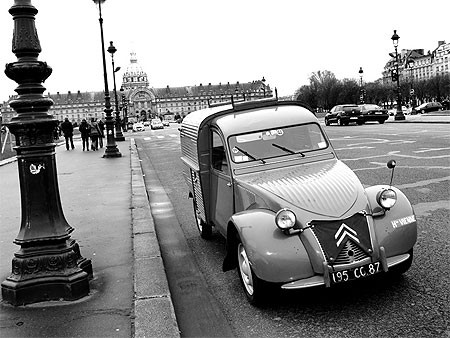
Pierre LE VIGAN
Ex: http://metamag.fr
00:05 Publié dans Histoire, Livre, Livre | Lien permanent | Commentaires (0) | Tags : histoire, france, trente glorieuses, livre |  |
|  del.icio.us |
del.icio.us |  |
|  Digg |
Digg | ![]() Facebook
Facebook
dimanche, 29 septembre 2013
Montherlant und der nutzlose Dienst

Montherlant und der nutzlose Dienst
von Jens Strieder
Ex: http://www.blauenarzisse.de
Die wichtigsten Auszüge aus Henry de Montherlants 1939 erstveröffentlichter Essaysammlung wurden im Verlag Antaios wieder aufgelegt.
Vielen deutschen Lesern ist der Name Henry Marie Joseph Frédéric Expedite Millon de Montherlant nicht mehr geläufig. Das gilt auch für sein Heimatland Frankreich. Es ist umso verwunderlicher, wenn man bedenkt, dass es sich bei dem 1895 in Paris geborenen Literaten um ein Ausnahmetalent handelte, das in nahezu allen Textformen zu Hause war: Montherlant schrieb Romane, Erzählungen, Novellen, Theaterstücke, Essays und Tagebücher. Sein Gedankenreichtum, seine Beobachtungsgabe und die durch ihre Schönheit bestechende Ausdruckskraft, sprechen für sich und machen ihn zu einem der bedeutendsten Schriftsteller des 20. Jahrhunderts.
Das Nutzlose liegt nicht im Trend
1939 erschien in Leipzig sein Essay-Band mit dem Titel „Nutzloses Dienen”. Damit diese Texte nicht vollends in Vergessenheit geraten, ist im Verlag Antaios ein Band erschienen, der in Form von fünf Essays eine Auswahl der im Original vertretenen Schriften aus den Jahren 1928 – 1934 versammelt.
Die Namensgebung des Bandes verweist sogleich auf eine literarische, aber auch lebenspraktisch orientierte Selbstkonzeption Montherlants: Eine persönliche Haltung, die einem scheinbar sinnlosen oder gar unsinnigen Handeln einen eigentümlichen Wert jenseits jeglichen oberflächlichen Utilitarismus’ beimisst.
Das Nutzlose liegt nicht im Trend, erschließt sich nicht jedem und ist vornehmlich Selbstzweck, dessen idealistischer Wert in der Herauslösung aus dem Alltäglichen, Banalen und Kollektiven liegt. Dabei dient es Montherlant auch zur Überwindung des Nihilismus: „Was mich aufrecht hält auf den Meeren des Nichts, das ist allein das Bild, das ich mir von mir selber mache”.
Der überzeitliche Wert des eigenen Handelns
Allein dieser Satz macht deutlich, dass sich die Dienerschaft auf den Dienenden selbst bezieht. Eine derartige Selbstkonzeption sollte nicht als Ausdruck von Arroganz oder Narzissmus missverstanden werden. Vielmehr geht es Montherlant darum, dem eigenen Wirken einen ideellen und überzeitlichen Wert jenseits des Egos beizugeben.
Ein solches Verständnis vom irdischen Dasein schlägt sich dann auch in allen fünf hier enthaltenen Texten nieder. Entscheidend scheint hierbei vor allem der Umstand zu sein, dass sich Montherlants Ethik eines nutzlosen Dienstes bei aller inneren Höhe, durch eine spezielle Form von Askese auszeichnet, die nicht nur auf Anerkennung von außen verzichtet, sondern auch nicht nach sichtbaren Bezeugungen giert.
So ist für Montherlant beispielsweise die Architektur ein Spiegel dieser Ethik. Wo das Versailler Schloß in erster Linie durch äußeren Glanz und Prunk wirkt, jedoch nach Meinung von Montherlant nicht darüber hinausschaut, sind beispielsweise die spanischen Paläste durch die Verbindung von Schnörkel und schlichtester Einfachheit ein Zeichen von Strenge, welche zum unabdingbaren Wesensmerkmal echter Größe gehört.
Montherlants Selbstkonzeption als Habitus
Für Montherlant sind deshalb die einzig wertvollen Kronen diejenigen, die man sich selbst gibt, denn „[…] die gute Tat geht nicht verloren, wie vergebens sie auch gewesen ist […].” Entsprechend wird auch die „sittliche Idee” der Ehre verteidigt, die auch dann zu wahren ist, wenn sie anderen als unangemessen oder gar lächerlich erscheinen mag.
Das „Heldentum des Alltags” ist nicht weniger bedeutsam als beispielsweise jenes im Krieg und anderen Ausnahmesituationen. Vielmehr ist es Bestandteil der Würde des Menschen. Montherlant setzt nicht einfach andere Prioritäten als jene, die ihm hier nicht folgen können, sondern er wird auch zum Schöpfer seiner selbst, indem er die Rolle konzipiert, die er als endliches Wesen im Fortgang der Zeit spielen möchte – nicht als Schauspieler, sondern als Resultat eines inneren Bedürfnisses.
Somit ist es nur logisch, sich nicht mit dem von niederen Instinkten geleiteten, hässlichen gemein machen zu wollen. Der nutzlose Dienst ist so auch immer ein Akt der bewussten Sezession.
Die Unabhängigkeit des Schriftstellers
Zugleich grenzt Montherlant in einem ebenfalls abgedruckten Vortrag, den der er am 15. November 1933 vor Offizieren der Kriegsakademie hielt, jenes Handeln aus Pflichtgefühl, Notwendigkeit oder edlen Motiven gegen ein Ehrverständnis ab, das der Unbesonnenheit anheim fällt und aus Dummheit und Leichtsinn Risiken eingeht und andere Leben gefährdet.
In Der Schriftsteller und das öffentliche Wirken fordert Montherlant die Freiheit der Unbhängigkeit des Schriftstellers von gesellschaftlich relevanten Themen ein. Er wendet sich gegen das Schubladendenken und die Erwartungshaltung des Kulturbetriebs, die letztlich den wesentlichen Teil des dichterischen Ausdrucks unterdrücken. Vor dem Hintergrund der heute üblichen, feuilletonistischen Simplifizierungen und Rollenzuschreibungen kann man mit Gewissheit sagen, dass dieses Anliegen berechtigt war.
Existentielle Bedrohung von innen oder außen
In einer Lage existentieller Bedrohung von innen oder außen dagegen sieht Montherlant den Schriftsteller dennoch in der Pflicht, seinen Beitrag zu leisten. Das verdeutlicht, dass die konstatierte Eigenart keine Ausrede für Verantwortungslosigkeit oder Feigheit sein kann. Ein geistig-moralischer Führungsanspruch im Sinne einer „engagierten Literatur” lässt sich hieraus jedoch keineswegs ableiten und wird vom Autor auch verworfen.
Für alle, die sich für diesen großen Geist interessieren, stellt der Band trotz seiner Knappheit den idealen Einstieg für eine tiefergehende Beschäftigung mit dessen Werk und Wirkung dar.
Henry de Montherlant: Nutzloses Dienen. 88 Seiten, Verlag Antaios 2011. 8,50 Euro.
00:05 Publié dans Littérature, Livre, Livre | Lien permanent | Commentaires (0) | Tags : livre, lettres, littérature, lettres françaises, littérature française, france, montherlant |  |
|  del.icio.us |
del.icio.us |  |
|  Digg |
Digg | ![]() Facebook
Facebook
mercredi, 25 septembre 2013
Pour une critique positive
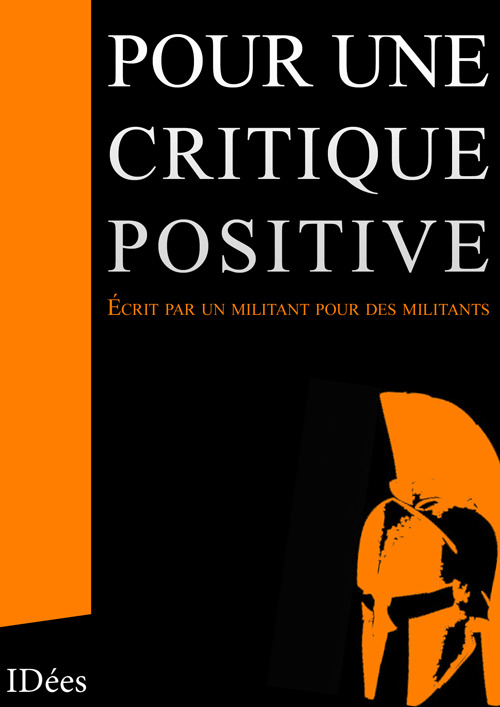
La première publication de Pour une critique positive est datée de 1962. Rédigé en détention (les prisons de la République hébergeaient alors de nombreux patriotes coupables d’avoir participé à la défense des Français d’Algérie), ce texte est un exercice d’autocritique sans comparaison « à droite ».
S’efforçant de tirer les enseignements des échecs de son action, l’auteur propose une véritable théorie de l’action révolutionnaire. Pour une critique positive a été une influence stratégique majeure pour de très nombreux militants, des activistes estudiantins des années 70 aux identitaires.
Pour une critique positive a été publié sous anonymat, comme c’est souvent le cas pour ce type de textes d’orientation, mais il est aujourd’hui communément admis que Dominique Venner en fut l’auteur. C’était avant qu’il quitte le terrain de l’action politique pour se consacrer à l’histoire.
Nous avons souhaité conserver l’œuvre originale dans son intégralité, les références ou le vocabulaire employés dans le texte pourront parfois surprendre ou choquer. S’il arrive que les mots soient durs, c’est que l’époque et les épreuves traversées l’étaient.
00:05 Publié dans Livre, Livre, Nouvelle Droite | Lien permanent | Commentaires (0) | Tags : dominique venner, nouvelle droite, critique positive, livre |  |
|  del.icio.us |
del.icio.us |  |
|  Digg |
Digg | ![]() Facebook
Facebook
lundi, 23 septembre 2013
La teoria etnonazionalista
La teoria etnonazionalista

00:05 Publié dans Livre, Livre, Terroirs et racines, Théorie politique | Lien permanent | Commentaires (0) | Tags : ethno-nationalisme, ethnies, livre, théorie politique, sciences politiques, politologie, ethnisme |  |
|  del.icio.us |
del.icio.us |  |
|  Digg |
Digg | ![]() Facebook
Facebook
dimanche, 22 septembre 2013
Technopol und Maschinen-Ideologien
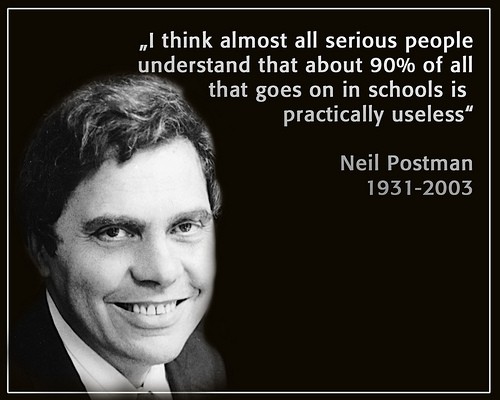
Robert Steuckers:
Technopol und Maschinen-Ideologien
Analyse: Neil POSTMAN, Das Technopol. Die Macht der Technologien und die Entmündigung der Gesellschaft, S. Fischer Verlag, 1991, 221 S., ISBN 3-10-062413-0.
Neil Postman, zeitgenößischer amerikanischer Denker und Soziolog, ist hauptsächlich für seine Bücher über die Fernsehen-Gefahren bei Kindern bekannt. In seinem Buch Das Technopol klagt er den Technizismus an, wobei er nicht die Technik als solche ablehnt, sondern die Mißbräuche davon. In seiner Einleitung, spricht Postman eine deutliche Sprache: Die Technik ist zwar dem Menschen freundlich, sie erleichtert ihm das Leben, aber hat auch dunkle Seiten. Postman: «Ihre Geschenke sind mit hohen Kosten verbunden. Um es dramatisch zu formulieren: man kann gegen die Technik den Vorwurf erheben, daß ihr unkontrolliertes Wachstum die Lebensquellen der Menschheit zerstört. Sie schafft eine Kultur ohne moralische Grundlage. Sie untergräbt bestimmte geistige Prozesse und gesellschaftliche Beziehungen, die das menschliche Leben lebenswert machen» (S. 10). Weiter legt Postman aus, was die Maschinen-Ideologien eigentlich sind und welche Gefahren sie auch in sich tragen. Postman macht uns darauf aufmerksam, das gewisse Technologien unsichtbar sein können: so Postman: «Management, ähnlich der Statistik, des IQ-Messung, der Notengebung oder der Meinungsforschung, funktionniert genau wie eine Technologie. Gewiß, es besteht nicht aus mechanischen Teilen. Es besteht aus Prozeduren und Regeln, die Verhalten standardisieren sollen. Aber wir können ein solches Prozeduren- und Regelsystem als eine Verfahrensweise oder eine Technik bezeichnen; und von einer solchen Technik haben wir nichts zu befürchten, es sei denn, sie macht sich, wie so viele unserer Maschinen, selbstständig. Und das ist der springende Punkt. Unter dem Technopol neigen wir zu der Annahme, daß wir unsere Ziele nur erreichen können, wenn wir den Verfahrensweisen (und den Apparaten) Autonomie geben.
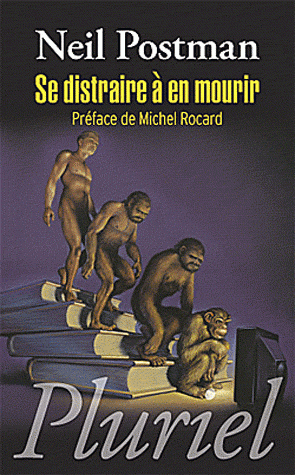 Diese Vorstellung ist um so gefährlicher, als sie niemand mit vernünftigen Gründen gegen den rationalen Einsatz von Verfahren und Techniken stellen kann, mit denen sich bestimmte Vorhaben verwirklichen lassen. (...) Die Kontroverse betrifft den Triumph des Verfahrens, seine Erhöhung zu etwas Heiligem, wodurch verhindert wird, daß auch andere Verfahrensweisen eine Chance bekommen» (S. 153-154). Weiter warnt uns Postman von einer unheimlichen Gefahr, d. h. die Gefahr der Entleerung der Symbole. Wenn traditionnelle oder religiöse Symbole beliebig manipuliert oder verhöhnt werden, als ob sie mechanische Teilchen wären, entleeren sie sich. Hauptschuldige daran ist die Werbung, die einen ständig größeren Einfluß über unseres tägliche Denken ausübt und die die Jugend schlimm verblödet, so daß sie alles im Schnelltempo eines Werbungsspot verstehen will. Um Waren zu verkaufen, manipulieren die Werbeleute gut bekannte politische, staatliche oder religiöse Symbole. Diese werden dann gefährlich banalisiert oder lächerlich gemacht, dienen nur noch das interressierte Verkaufen, verlieren jedes Mysterium, werden nicht mehr mit Andacht respektiert. So verlieren ein Volk oder eine Kultur ihren Rückengrat, erleben einen problematischen Sinnverlust, der die ganze Gemeinschaft im verheerenden Untergang stoßen. Postmans Bücher sind wichtig, weil sie uns ganz sachlich auf zeitgenößischen Problemen aufmerksam machen, ohne eine peinlich apokalyptische Sprache zu verwenden. Zum Beispiel ist Postman klar bewußt, daß die Technik lebenswichtig für den Menschen ist, denunziert aber ohne unnötige Pathos die gefährliche Autonomisierung von technischen Verfahren. Postman plädiert nicht für eine irrationale Technophobie. Schmittianer werden in seiner Analyse der unsichtbaren Technologien, wie das Management, eine tagtägliche Quelle der Delegitimierung und Legalisierung der politischen Gemeinschaften. Politisch gesehen, könnten die soziologischen Argumente und Analysen von Postman eine nützliche Illustration der Legalität/Legitimität-Problematik sein (Robert STEUCKERS).
Diese Vorstellung ist um so gefährlicher, als sie niemand mit vernünftigen Gründen gegen den rationalen Einsatz von Verfahren und Techniken stellen kann, mit denen sich bestimmte Vorhaben verwirklichen lassen. (...) Die Kontroverse betrifft den Triumph des Verfahrens, seine Erhöhung zu etwas Heiligem, wodurch verhindert wird, daß auch andere Verfahrensweisen eine Chance bekommen» (S. 153-154). Weiter warnt uns Postman von einer unheimlichen Gefahr, d. h. die Gefahr der Entleerung der Symbole. Wenn traditionnelle oder religiöse Symbole beliebig manipuliert oder verhöhnt werden, als ob sie mechanische Teilchen wären, entleeren sie sich. Hauptschuldige daran ist die Werbung, die einen ständig größeren Einfluß über unseres tägliche Denken ausübt und die die Jugend schlimm verblödet, so daß sie alles im Schnelltempo eines Werbungsspot verstehen will. Um Waren zu verkaufen, manipulieren die Werbeleute gut bekannte politische, staatliche oder religiöse Symbole. Diese werden dann gefährlich banalisiert oder lächerlich gemacht, dienen nur noch das interressierte Verkaufen, verlieren jedes Mysterium, werden nicht mehr mit Andacht respektiert. So verlieren ein Volk oder eine Kultur ihren Rückengrat, erleben einen problematischen Sinnverlust, der die ganze Gemeinschaft im verheerenden Untergang stoßen. Postmans Bücher sind wichtig, weil sie uns ganz sachlich auf zeitgenößischen Problemen aufmerksam machen, ohne eine peinlich apokalyptische Sprache zu verwenden. Zum Beispiel ist Postman klar bewußt, daß die Technik lebenswichtig für den Menschen ist, denunziert aber ohne unnötige Pathos die gefährliche Autonomisierung von technischen Verfahren. Postman plädiert nicht für eine irrationale Technophobie. Schmittianer werden in seiner Analyse der unsichtbaren Technologien, wie das Management, eine tagtägliche Quelle der Delegitimierung und Legalisierung der politischen Gemeinschaften. Politisch gesehen, könnten die soziologischen Argumente und Analysen von Postman eine nützliche Illustration der Legalität/Legitimität-Problematik sein (Robert STEUCKERS).
00:05 Publié dans Livre, Livre, Nouvelle Droite, Philosophie, Sociologie | Lien permanent | Commentaires (0) | Tags : neil postman, technocratisme, livre, synergies européennes, nouvelles droite, robert steuckers |  |
|  del.icio.us |
del.icio.us |  |
|  Digg |
Digg | ![]() Facebook
Facebook
samedi, 21 septembre 2013
Kerry Bolton: Revolution from Above
Kerry Bolton: Revolution from Above
By Manfred Kleine-Hartlage
Ex: http://www.sezession.de
 Jeder, der einmal versucht oder auch nur theoretisch erwogen hat, einen größeren geistig-politischen Umschwung herbeizuführen – von einer Revolution ganz zu schweigen –, weiß, daß dazu vor allem eines erforderlich ist: Geld.
Jeder, der einmal versucht oder auch nur theoretisch erwogen hat, einen größeren geistig-politischen Umschwung herbeizuführen – von einer Revolution ganz zu schweigen –, weiß, daß dazu vor allem eines erforderlich ist: Geld.
Geld bringt Journalisten dazu, bestimmte Themen hoch- oder niederzuschreiben, Geld veranlaßt Professoren, ihre Erkenntnisinteressen denen ihrer Drittmittelgeber anzupassen, Geld ermöglicht es, Zeitungen und Fernsehsender zu kaufen, mit Geld kann man Kurse für Agitatoren und solche, die es werden wollen, bezahlen, mit Geld eine Infrastruktur von „Nichtregierungsorganisationen“ unterhalten, und wenn all dies nicht reicht, kann man mit Geld Waffen kaufen.
Obwohl dies so offenkundig ist, daß man es schon banal nennen muß, ist es zugleich ein Tabuthema. Jeder weiß zwar, daß etwa die Bolschewiki eine Organisation von „Berufsrevolutionären“ waren; und jeder, der darüber nachdenkt, könnte sich sagen, daß Berufsrevolutionäre – wie alle anderen Berufstätigen auch – auf Arbeitgeber oder Kunden angewiesen sind, die sie bezahlen. Und doch gilt die Oktoberrevolution bis heute als das Werk eines gewissen Lenin, nicht etwa als das seiner Geldgeber. Allenfalls gesteht man zu, daß die Millionensummen, die die deutsche Regierung während des Ersten Weltkriegs zur Verfügung stellte, eine gewisse Rolle gespielt haben mögen. Daß entsprechende Summen aber schon lange vor dem Ersten Weltkrieg an die Bolschewisten und andere revolutionäre Organisationen flossen, und daß sie keineswegs aus Deutschland stammten, sondern aus amerikanischen Finanzkreisen: Das ist zwar kein Geheimnis, sondern wohldokumentiert; im offiziösen Geschichtsbild kommt es aber nicht vor.
Dabei ist die Russische Revolution noch dasjenige Thema, bei dem der kausale Zusammenhang zwischen den Interessen schwerreicher Finanziers und der Entfesselung der Revolution am ehesten thematisiert werden kann. Wer dagegen fragt, warum 1789 wie auf Kommando in ganz Frankreich Agitatoren auftauchten, die ein gar nicht so unzufriedenes Volk aufzuhetzen verstanden, sieht sich schnell als „Verschwörungstheoretiker“ abgestempelt, und erst recht gilt dies für den, der den ominösen „Zeitgeist“ hinterfragt, der – man weiß nicht wie – seit rund hundert Jahren, spätestens aber seit dem Zweiten Weltkrieg, grundsätzlich nur von links zu wehen scheint.
Wiederum ist es nicht wirklich ein Geheimnis, daß dieser Zeitgeist keineswegs von selbst entstanden ist, und es ist auch kein Geheimnis, wer seine Entstehung organisiert und finanziert hat: Die verantwortlichen Akteure rühmen sich dessen sogar und geben in ihren Veröffentlichungen detailliert Auskunft darüber. Und doch haben diese allgemein zugänglichen Informationen kaum Eingang ins herrschende politische Bewußtsein gefunden.
In seinem Buch „Revolution from Above“ [2], das zur Zeit leider nur auf Englisch verfügbar ist, hat der neuseeländische Autor Kerry Bolton diese Informationen zusammengetragen und zu einem theoretisch überzeugenden und empirisch unanfechtbar untermauerten Ganzen zusammengefügt. Er weist überzeugend – und dies ausschließlich auf der Basis von Selbstzeugnissen der einschlägigen Akteure! – nach, daß praktisch alle intellektuellen und politischen Strömungen der Linken im 20. Jahrhundert, soweit sie nicht von der UdSSR finanziert wurden, nur aufgrund der milliardenschweren Unterstützung durch eine winzige Schicht von amerikanischen Superreichen und deren Stiftungen zum Zuge kommen konnten. Zumindest hätten sie ohne diese Unterstützung bei weitem nicht die Durchschlagskraft haben können, die sie haben.
Ein solcher Befund mag denjenigen überraschen, der den Gegensatz von Kapitalisten und Sozialisten immer noch für unüberbrückbar hält. Tatsächlich war er das nie. Die Linke leistet dem Kapital vielmehr gute Dienste bei der Zerstörung hergebrachter Strukturen, Bindungen und Werte. Sie planiert damit das Gelände, auf dem der globale Kapitalismus errichtet wird. Sie zerstört reale, gewachsene Solidarität im Namen einer fiktiven und bloß ideologisch postulierten, und sie erzeugt damit die Gesellschaft von atomisierten Einzelnen, die auf ihre Rolle als Produzenten und Konsumenten zurückgeworfen werden und als Masse so lenkbar und nutzbar sind wie eine Viehherde. Das gilt für die russischen und chinesischen Kommunisten, die eine traditionelle agrarische Gesellschaft ins Industriezeitalter katapultierten und schließlich in den Weltmarkt einbanden; es gilt genauso für die westliche Linke mit ihrem Kampf gegen Nation, Tradition, Religion und Familie.
Boltons Buch ist die passende Ergänzung zu meinen eigenen Ausführungen zu diesem Thema (in „Die liberale Gesellschaft und ihr Ende“ [3]). Wo ich die Zusammenhänge abstrakt analysiere, nennt er konkrete Namen, Summen, Profiteure und Strategien. Steinchen für Steinchen entsteht dabei das Mosaik einer langfristigen Strategie der amerikanischen Plutokratie, die auf nicht mehr und nicht weniger hinausläuft als auf eine Weltrevolution – eben auf die Revolution von oben, der das Buch seinen Titel verdankt.
Solche Bücher können auch entmutigen: Wie will man denn, so mag mancher Leser fragen, einem Feind entgegentreten, der an allen Fronten unter Einsatz schier unbegrenzter Mittel auf dem Vormarsch ist? Ist da nicht jeder Widerstand von vornherein zumm Scheitern verurteilt?
Ich selbst ziehe den umgekehrten Schluß: Wenn der Feind Milliardensummen einsetzt, dann deshalb, weil er es nötig hat. Wer ganze Völker mit einem geschlossenen System von Lügen indoktrinieren muss, muß wesentlich mehr investieren als der, der es sich leisten kann, mit Wahrheiten zu operieren. Freilich rechtfertigt auch diese Feststellung nicht eine in manchen Kreisen immer noch verbreitete naive rechte Sozialromantik, die ohne professionelle Strukturen auszukommen glaubt, weil die Wahrheit sich allein durch den Idealismus ihrer Verfechter durchsetzen werde.
Kerry Boltons Buch ist insofern kein Anlaß zu Resignation, wohl aber zu produktiver Ernüchterung: Wir kommen mit weniger Geld aus als der Gegner, aber auch wir werden viele Millionen Euro benötigen, um einen spürbaren politischen Effekt zu erzielen. Es wird Zeit, daß diese Einsicht sich unter den besser betuchten Sympathisanten der politischen Rechten herumspricht.
Article printed from Sezession im Netz: http://www.sezession.de
URL to article: http://www.sezession.de/40908/kerry-bolton-revolution-from-above.html
URLs in this post:
[1] Image: http://www.sezession.de/wp-content/uploads/2013/09/kerry-bolton-revolution-from-above.jpg
[2] „Revolution from Above“: http://www.arktos.com/revolution-from-above.html
[3] „Die liberale Gesellschaft und ihr Ende“: http://antaios.de/detail/index/sArticle/314/sCategory/13
19:09 Publié dans Livre, Livre, Nouvelle Droite | Lien permanent | Commentaires (0) | Tags : kerry bolton, nouvelle droite américaine, livre |  |
|  del.icio.us |
del.icio.us |  |
|  Digg |
Digg | ![]() Facebook
Facebook
jeudi, 19 septembre 2013
Silvio Gesell: der “Marx” der Anarchisten
Robert STEUCKERS:
Silvio Gesell: der “Marx” der Anarchisten
Analyse: Klaus SCHMITT/Günter BARTSCH (Hrsg.), Silvio Gesell, “Marx” der Anarchisten. Texte zur Befreiung der Marktwirtschaft vom Kapitalismus und der Kinder und Mütter vom patriarchalischen Bodenunrecht, Karin Kramer Verlag, Berlin, 1989, 303 S., ISBN 3-87956-165-6.
 Silvio Gesell war ein nonkonformistischer Ökonom. Er nahm zusammen mit Figuren sowie Niekisch, Mühsam und Landauer an der Räteregierung Bayerns teil. Der gebürtige Sankt-Vikter entwickelte in seinem wichtigsten Buch “Die natürliche Ordnung” ein Projekt der Umverteilung des Bodens, damit ein Jeder selbständig-autonom in totaler Unabhängigkeit von abstrakten Strukturen leben konnte. Günter Bartsch nennt ihn ein “Akrat”, d.h. ein Mensch, der frei von jeder Bevormündung ist, sei diese politischer, religiöser oder verwaltungsartiger Natur. Für Klaus Schmitt, der Gesell für die deutsche nonkonforme Linke wiederentdeckt (aber nicht kritiklos), ist der räterepublikanische Akrat ein der schärfsten Kritiker der “Macht Mammons”. Diese Allmacht wollte Gesell mit der Einführung eines “Schwundgeldes” bzw. einer “Freigeld-Lehre” zerschmettern. Unter “Schwundgeld” verstand er ein Geld, das man nicht thesaurisieren konnte und für das keine Zinsen gezahlt wurden. Im Gegenteil war für Gesell die Hortung von Geldwerten die Hauptsünde. Geld, das nicht in Sachen (Maschinen, Geräte, Technik, Erziehung, Boden, Vieh, usw.) investiert wird, mußte durch moralischen und ökonomischen Zwang an Wert verlieren. Solche Ideen entwickelten auch der Vater des kanadischen und angelsächsichen Distributismus, C. H. Douglas, und der Dichter Ezra Pound, der in den amerikanischen Regierung ein Instrument des Teufels Mammon sah. Douglas entwickelte distributistische Bauern-Projekte in Kanada, die teilweise noch heute existieren. Pound drückte seinen Dichterhaß gegen Geld- und Bankwesen, indem er die italienischen “Saló-Republik” am Ende des Krieges unterstütze. Pound versuchte, seine amerikanische Landgenossen zu überzeugen, keinen Krieg gegen Mussolini und das spätfaschistischen Italien zu führen. Nach 1945, wurde er in den VSA zwölf Jahre lang in einer Irrenanstalt eingesperrt. Er kam trotzdem aus dieser Hölle ungebrochen zurück und ging bei seiner Dochter Mary de Rachewiltz in Südtirol wohnen, wo er 1972 starb.
Silvio Gesell war ein nonkonformistischer Ökonom. Er nahm zusammen mit Figuren sowie Niekisch, Mühsam und Landauer an der Räteregierung Bayerns teil. Der gebürtige Sankt-Vikter entwickelte in seinem wichtigsten Buch “Die natürliche Ordnung” ein Projekt der Umverteilung des Bodens, damit ein Jeder selbständig-autonom in totaler Unabhängigkeit von abstrakten Strukturen leben konnte. Günter Bartsch nennt ihn ein “Akrat”, d.h. ein Mensch, der frei von jeder Bevormündung ist, sei diese politischer, religiöser oder verwaltungsartiger Natur. Für Klaus Schmitt, der Gesell für die deutsche nonkonforme Linke wiederentdeckt (aber nicht kritiklos), ist der räterepublikanische Akrat ein der schärfsten Kritiker der “Macht Mammons”. Diese Allmacht wollte Gesell mit der Einführung eines “Schwundgeldes” bzw. einer “Freigeld-Lehre” zerschmettern. Unter “Schwundgeld” verstand er ein Geld, das man nicht thesaurisieren konnte und für das keine Zinsen gezahlt wurden. Im Gegenteil war für Gesell die Hortung von Geldwerten die Hauptsünde. Geld, das nicht in Sachen (Maschinen, Geräte, Technik, Erziehung, Boden, Vieh, usw.) investiert wird, mußte durch moralischen und ökonomischen Zwang an Wert verlieren. Solche Ideen entwickelten auch der Vater des kanadischen und angelsächsichen Distributismus, C. H. Douglas, und der Dichter Ezra Pound, der in den amerikanischen Regierung ein Instrument des Teufels Mammon sah. Douglas entwickelte distributistische Bauern-Projekte in Kanada, die teilweise noch heute existieren. Pound drückte seinen Dichterhaß gegen Geld- und Bankwesen, indem er die italienischen “Saló-Republik” am Ende des Krieges unterstütze. Pound versuchte, seine amerikanische Landgenossen zu überzeugen, keinen Krieg gegen Mussolini und das spätfaschistischen Italien zu führen. Nach 1945, wurde er in den VSA zwölf Jahre lang in einer Irrenanstalt eingesperrt. Er kam trotzdem aus dieser Hölle ungebrochen zurück und ging bei seiner Dochter Mary de Rachewiltz in Südtirol wohnen, wo er 1972 starb.
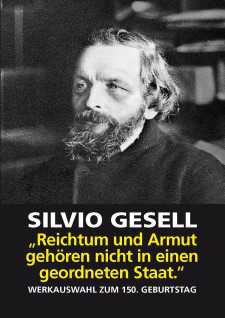 Neben seiner ökonomischen Lehren über das Schwund- und Freigeld, theorisierte Gesell einen Anarchofeminismus, wobei er besonders die Kinder und die Frauen gegen männliche Ausbeutung schützen wollte. Diese Interpretation des matriarchalischen Archetyp implizierte eine ziemlich scharfe Kritik des Vaterrechts, der in seinen Augen die Position der Kinder in der Gesellschaft besonders labil machte. Insofern war Gesell ein Vorfechter der Kinderrechte. Praktish bedeutete dieser Anarchofeminismus die Einführung einer “Mutterrente”. «Gesell und sein Anhänger wollten den gesamten Boden den Müttern zueignen und ihnen bzw. ihren Kinder die Bodenrente bis zum 18. Lebensjahr der Kinder als “Mutter-” bzw. “Kinderrente” zukommen lassen. Ein “Bund der Mütter” soll den gesamten nationalen und in ferner Zukunft den gesamten Boden unseres Planeten verwalten und (...) an den oder die Meistbietenden verpachten. Nach diesem Verfahren hätte jeder einzelne Mensch und jede einzelne Gruppe (z. B. eine Genossenschaft) die gleichen Chancen wie alle anderen, Boden nutzen zu können, ohne von privaten oder staatlichen Parasiten ausgebeutet zu werden» (S. 124). Wissenschaftliche Benennung dieses Systems nach Gesell hieß “physiokratische Mutterschaft”.
Neben seiner ökonomischen Lehren über das Schwund- und Freigeld, theorisierte Gesell einen Anarchofeminismus, wobei er besonders die Kinder und die Frauen gegen männliche Ausbeutung schützen wollte. Diese Interpretation des matriarchalischen Archetyp implizierte eine ziemlich scharfe Kritik des Vaterrechts, der in seinen Augen die Position der Kinder in der Gesellschaft besonders labil machte. Insofern war Gesell ein Vorfechter der Kinderrechte. Praktish bedeutete dieser Anarchofeminismus die Einführung einer “Mutterrente”. «Gesell und sein Anhänger wollten den gesamten Boden den Müttern zueignen und ihnen bzw. ihren Kinder die Bodenrente bis zum 18. Lebensjahr der Kinder als “Mutter-” bzw. “Kinderrente” zukommen lassen. Ein “Bund der Mütter” soll den gesamten nationalen und in ferner Zukunft den gesamten Boden unseres Planeten verwalten und (...) an den oder die Meistbietenden verpachten. Nach diesem Verfahren hätte jeder einzelne Mensch und jede einzelne Gruppe (z. B. eine Genossenschaft) die gleichen Chancen wie alle anderen, Boden nutzen zu können, ohne von privaten oder staatlichen Parasiten ausgebeutet zu werden» (S. 124). Wissenschaftliche Benennung dieses Systems nach Gesell hieß “physiokratische Mutterschaft”.
Neben den langen Aufsätzen von Bartsch und Schmitt enthält das Buch auch Texte von Gustav Landauer (“Sehr wertvolle Vorschläge”) und Erich Mühsam (“Ein Wegbahner. Nachruf zum Tode Gesells 1930”).
Fazit: Das Buch hilft uns, die Komplexität und Verwicklung von Ideen zu verstehen, die in der Räterepublik anwesend waren. Ist Niekisch wiederentdeckt und breit kommentiert, so ist seine Nähe zu Personen wie Landauer, Mühsam und Gesell kaum erforscht. Auch interressant wäre es, die Beziehungspunkte zwischen Gesell, Douglas und Pound zu analysieren und zu vergleichen. Letztlich wäre es auch, die Lehren Gesells mit den national-revolutionären Theorien eines Henning Eichbergs in den Jahren 60 und 70 und mit dem Gedankengut, das eine Zeitschrift wie Wir Selbst verbreitet hat. Eichberg hat ja auch immer den Akzent auf das Mütterliche gelegt. Er sprach eher von einem mütterlich-schützende Mutterland statt von einem patriarchalisch-repressive Vaterland. Ähnlichkeiten, die der Ideen-Historiker nicht vernachlässigen kann (Robert STEUCKERS).
00:05 Publié dans Histoire, Livre, Livre, Nouvelle Droite, Synergies européennes, Théorie politique | Lien permanent | Commentaires (0) | Tags : silvio gesell, anarchisme, allemagne, histoire, nouvelle droite, théorie politique, sciences politiques, politologie |  |
|  del.icio.us |
del.icio.us |  |
|  Digg |
Digg | ![]() Facebook
Facebook
vendredi, 13 septembre 2013
Pour une séparation du Laïcisme et de l'État
Pour une séparation du Laïcisme et de l'État
par Jean-Gilles MALLIARAKIS
Ex: http://www.insolent.fr
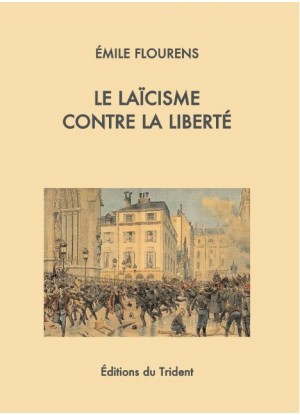 Peillon s'est encore fait remarquer pour la rentrée scolaire. Le personnage communique beaucoup. Tel Robespierre, qu'il admire et qui, cependant signa son arrêt de mort à la Fête de l'Être suprême, il pose en grand maître d'une religion [presque] nouvelle.
Peillon s'est encore fait remarquer pour la rentrée scolaire. Le personnage communique beaucoup. Tel Robespierre, qu'il admire et qui, cependant signa son arrêt de mort à la Fête de l'Être suprême, il pose en grand maître d'une religion [presque] nouvelle.
Tout cela le prétentieux personnage l'écrit lui-même.
Qu'on en juge par ses propres citations :
On remarquera d'abord que, comme beaucoup d'esprits marqués par l'enseignement de la philosophie, il fait bon marché de la connaissance concrète de l'Histoire. Voici en effet comment il définit la révolution :
"La révolution française est l’irruption dans le temps de quelque chose qui n’appartient pas au temps, c’est un commencement absolu, c’est la présence et l’incarnation d’un sens, d’une régénération et d’une expiation du peuple français. 1789, l’année sans pareille, est celle de l’engendrement par un brusque saut de l’histoire d’un homme nouveau. La révolution est un événement méta-historique, c’est-à-dire un événement religieux." (1)⇓
Et il enchaîne donc par cette conclusion, certes logique, mais terrifiante :
"La révolution implique l’oubli total de ce qui précède la révolution. Et donc l’école a un rôle fondamental, puisque l’école doit dépouiller l’enfant de toutes ses attaches pré-républicaines pour l’élever jusqu’à devenir citoyen. C’est une nouvelle naissance, une transsubstantiation qui opère dans l’école et par l’école cette nouvelle église avec son nouveau clergé, sa nouvelle liturgie, ses nouvelles tables de la loi."
On se situe exactement dans cette idée rousseauiste "il faut les forcer d'être libres" qu'Augustin Cochin souligne. (2)⇓
Peillon ose écrire : "La laïcité elle-même peut alors apparaître comme cette religion de la République recherchée depuis la Révolution". (3)⇓
Mais il déclare par ailleurs ouvertement que "la franc-maçonnerie est la religion de la république". (4)⇓
Le laïcisme qu'il professe se veut par conséquent l'expression profane, le mot d'ordre, – et comme le mot "républicain",– le mot de passe d'une secte, d'ailleurs divisée, dont on rappellera qu'au sein de l'Éducation dite Nationale elle doit représenter au maximum 1 % des fonctionnaires eux-mêmes, malgré sa réputation d'ascenseur professionnel : ce qui doit bien vouloir dire qu'elle dégoûte les autres 99 %.
Cessons donc de confondre laïcité et neutralité. L'un des fondateurs du système, Viviani, qui fut président du Conseil au moment de la déclaration de guerre de 1914, l'écrivait à l'époque: "La neutralité est, elle fut toujours un mensonge [...]. Un mensonge nécessaire lorsque l’on forgeait, au milieu des impétueuses colères de la droite, la loi scolaire [...]. On promit cette chimère de la neutralité pour rassurer quelques timidités dont la coalition eût fait obstacle au principe de la loi. Mais Jules Ferry avait l’esprit trop net pour croire en l’éternité de cet expédient [...]." (5)⇓
Le développement de l'éducation étatique a toujours été conçu en vue de perpétuer le système.
Le fonctionnement de cette coûteuse administration, lourdement centralisée, se révèle d'année en année plus improductif, et plus destructeur.
Les écoles d'État ne parviennent plus à enseigner aux enfants de France à lire, écrire et compter. Mais on veut, par l'effet du laïcisme totalitaire, faire semblant d'imposer avec une soi-disant "morale laïque", dont personne ne connaît les fondements, un recul de l'islamisme, lâchement, sans oser le nommer : cette rustine méprisable, poisseuse et liberticide ne servira à rien. Jetons la sans hésiter. Séparons le laïcisme de l'État.
JG Malliarakis
Apostilles
- cf. "La révolution française n’est pas terminée" Seuil 2008 page 17⇑
- *cf. "Les sociétés de pensée et la démocratie moderne" Éditions du Trident. ⇑
- Ibidem p. 162 ⇑
- cf. ses déclarations destinées à promouvoir son livre enregistrées au départ sur le site de son éditeur.⇑
- cf. L’Humanité 4 octobre 1904.⇑
Si vous appréciez le travail de L'Insolent
soutenez-nous en souscrivant un abonnement.
Pour recevoir régulièrement des nouvelles de L'Insolent
inscrivez-vous gratuitement à notre messagerie.
Si vous cherchez des lectures intelligentes pour l'été >
Visitez le catalogue des Éditions du Trident et commandez en ligne.
00:05 Publié dans Livre, Livre, Politique | Lien permanent | Commentaires (0) | Tags : jean-gilles malliarakis, laïcisme, laïcité, état, france, livre, europe, affaires européennes |  |
|  del.icio.us |
del.icio.us |  |
|  Digg |
Digg | ![]() Facebook
Facebook
jeudi, 12 septembre 2013
L’histoire fabriquée
Pierre LE VIGAN
Ex: http://metamag.fr
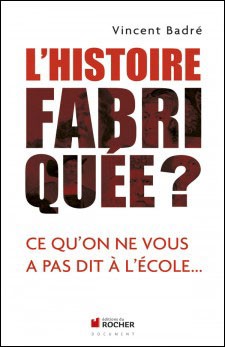 Peut mieux faire. C’est le moins que l’on puisse dire à propos de beaucoup de manuels scolaires d’histoire dans le secondaire. Mais il est vrai qu’il faudrait aussi plus de temps pour enseigner l’histoire. Vincent Badré remet les pendules à l’heure. Reprenant le contenu des principaux manuels en circulation il expose les faits et idées enseignées, indique leur part de vérité, mais parfois aussi leur part de contre-vérité.
Peut mieux faire. C’est le moins que l’on puisse dire à propos de beaucoup de manuels scolaires d’histoire dans le secondaire. Mais il est vrai qu’il faudrait aussi plus de temps pour enseigner l’histoire. Vincent Badré remet les pendules à l’heure. Reprenant le contenu des principaux manuels en circulation il expose les faits et idées enseignées, indique leur part de vérité, mais parfois aussi leur part de contre-vérité.
00:04 Publié dans Ecole/Education, Histoire, Livre, Livre | Lien permanent | Commentaires (0) | Tags : livre, histoire, école, éducation, enseignement |  |
|  del.icio.us |
del.icio.us |  |
|  Digg |
Digg | ![]() Facebook
Facebook
mardi, 10 septembre 2013
The Gentleman from Providence
The Gentleman from Providence
By Alex Kurtagić
Ex: http://www.counter-currents.com
S. T. Joshi
I Am Providence: The Life and Times of H. P. Lovecraft [2]
2 vols.
New York: Hippocampus Press, 2012
When it comes to a truly comprehensive biography of Howard Philip Lovecraft, one cannot do better than S. T. Joshi’s I am Providence, a 2 volume, 1,000-page, 500,000-word mammoth of a book that aims to cover everything there is to know about the American master of the weird tale.
As with Mark Finn, whose biography of Howard I reviewed recently, it would seem that L. Sprague de Camp was what spurred Joshi into action: after reading the latter’s Lovecraft: A Biography upon initial publication in 1975, Joshi dedicated his life thereafter to the study of the author from Providence. His choice of university was dictated by its holding the Lovecraft manuscript collection of the John Hay Library. And when he discovered that At the Mountains of Madness, his favourite Lovecraft story, contained no less than 1,500 textual errors, he devoted the ensuing years to tracking down and examining manuscripts and early publications in order to determine the textual history of the work and make possible a corrected edition of Lovecraft’s collected fiction, “revisions,” and other writings. What we have here, you may confidently conclude, is the product of decades of fanaticism and obsessive investigation.
Lovecraft was born in 1890, into a conservative upper middle class family, in Providence, Rhode Island. His father, Winfield, was a travelling salesman, employed by Gorham & Co., Silversmiths, and his mother, Sarah, could trace her ancestry back to the arrival of George Phillips to Massachusetts in 1630. His parents married in their thirties.
The young Lovecraft was talented, intellectually curious, and precocious, able to recite poetry by age two, and to read by age three. Growing up at a time when school was not compulsory, Lovecraft would not be enrolled in one until he was eight years of age and his attendance would be sporadic, possibly due to a nervous complaint and / or psychosomatic condition. But he was well ahead of his coevals in any event, having been exposed, and thereafter enjoyed ready access, to the best of classical and English literature. From Lovecraft’s perspective, this meant 17th and early 18th century prose and poetry, and, indeed, so steeped was he in the canonical literature from this period that he regarded its style of writing not only the finest ever achieved, but, for him, the norm. In the process, he also absorbed some of the archaic tastes and sensibilities permeating this literature, which would subsequently be reflected in his writing, speech, and attitudes, fundamentally aristocratic and at odds with the 20th century. What is more, Lovecraft was never denied anything he may have needed in the pursuit of his intellectual development, be it a chemistry set, a telescope, or printing equipment, so he became knowledgeable enough on these topics, and particularly his passion, astronomy, to contribute articles to a local publication from an early age. He also regularly produced—while still in infancy—his own amateur scientific journals, many of which still survive and were personally examined by Joshi for this biography. Thus, from early on, Lovecraft, a somewhat lonely boy with a charmed boyhood, was committed to a life entirely of the mind.
With such beginnings, it would appear to a casual observer that Lovecraft was well-equipped to become a success in life. But, instead, in adulthood he experienced ever-worsening poverty, squalor, and, though well known for a period within the specialised milieu of amateur publishing, growing professional obscurity. That his legacy has endured owes—besides to the intrinsic value of his works—perhaps in a not insignificant measure to his having been a prodigous correspondent: it has been estimated that throughout the course of his life Lovecraft may have written as many as 100,000 letters (only about 20,000 of which survive), and these were not hastily penned missives, as can be seen in the many excerpts herein presented, but thoughtful communications, sometimes of up to 30 pages in length, which are works of literatue in themselves.
In examining his overall trajectory, we can identify a number of negative vectors early on. The loss of his father, who, following a psychotic episode and permanent committal to a local hospital, suffering from what Joshi presumes to have been syphilis, meant that, from 1893, Lovecraft passed into the care of his mother, aunts, and his maternal grandfather. Whipple van Buren Phillips, a wealthy businessman, proved a positive influence, but died in 1904, and, his estate being poorly managed, this eventually forced the family to downsize. This badly affected the young Lovecraft, to the point that he briefly contemplated suicide. He was eventually dissuaded by his own intellectual curiosity and love of learning.
In 1908, just prior to his high school graduation, Lovecraft suffered a nervous breakdown. Joshi speculates that failure to master higher mathematics may have been a factor, since Lovecraft’s ambition was to become a professional astronomer. (Failure to master meant not getting straight As, but, among the As, a few A-s and Bs.) Whatever its cause, the breakdown prevented Lovecraft from obtaining his diploma, a fact he would later conceal or minimise. Lovecraft then went into seclusion—hikikomori, as it would be called today—in which condition he remained for five years, mostly reading and writing poetry. Joshi expresses alarm at the sheer volume of reading undertaken by Lovecraft during this period, a large portion of it consisting of magazines.
Lovecraft’s re-emergence owes to his irritation with a pulp author, Fred Jackson, whose stories in Argosy magazine he found maudlin, mediocre, and irritating. His letter was published in the magazine, whereby it detonated an opinionated debate. When Lovecraft’s expressed view led to attacks, he responded in lofty and witty verse, thus instigating a months-long war—in archaic rhyme—in the letters’ page. This got him noticed by the president of the United Amateur Press Association (UAPA), Edward F. Daas, who invited Lovecraft to join. This inaugurated Lovecraft’s amateur career, which led to his return to fiction—something he had dabbled in years before—and, by 1919, to his first commerically published work. During his early years in amateurdom, Lovecraft would also produce his own literary journal, The Conservative, a publication that truly lived up to its name and that has only recently been reprinted by Arktos in unabridged form.
Throughout this period Lovecraft continued to live with his mother, who sustained them both off an ever-shrinking inheritance. Trapped between the expectations of her class and dwindling resources, she grew progressively more neurotic and unstable. She already had an unheathily close, love-hate, relationship with her son, and Joshi records that she considered her son’s visage too ugly for public view. By 1919, suffering from hysteria and clinical depression, she would be committed to hospital, where she would remain for the rest of her days. Mother and son stayed close correspondents, but she was a perennial source of worry. Thus, when Sarah died in 1921, initial grief led to a sense of liberation, and an improvement in Lovecraft’s general health—though he, at this time a tall man of nearly 200 lbs, always regarded himself as ailing.
Yet there were further turns to the worst ahead. In 1921, at a convention for amateur journalists in Boston, Lovecraft met Sonia Green, an assimilated 38-year-old Ukrainian Jew from New York, whom he would marry in 1924. Interestingly, Lovecraft only told his aunt after the fact, writing to her from New York, where he had by then already taken residence at Sonia’s apartment.
Joshi notes that at this time Lovecraft’s prospects appeared to be improving: Sonia earned a good living at a hat shop in Fifth Avenue, and Lovecraft’s professional writing career was taking off. Lovecraft, then in a decadent phase, was also enthralled by the city, where he had a number of amateur friends. However, Sonia lost her job almost immediately when the shop went bankrupt. This forced Lovecraft for the first time to find regular employment, but without qualifications, work experience, nor, apparently, marketable skills, he was unable to find a position. The consequent financial difficulties impacted on Sonia’s health, who entered a sanatorium for a period of recovery. Eventually, she would find a job in Cleveland, leaving Lovecraft to live on his own, in a tiny apartment, in Brooklyn Heights (then Red Hook), back then a seedy neighbourhood. Sonia sent him an allowance, which permitted him to cover his rent and minimal expenses, but otherwise Lovecraft lived in poverty, stretching as far as possible a minuscule fare of unheated beans, bread, and cheese.
This was, however, genteel poverty. When, on one occasion, Lovecraft’s apartment was burglarised, he was left with only the clothes on his back (while he slept, the thieves gained access to his closet and stole all his suits). His reaction says much about Lovecraft: first priority for him was to get four new replacements: light and dark, winter and summer—no easy task, given his slender wallet. A gentleman may be poor, but he must still dress like a gentleman! The ensuing hunt for suitable attire taxed Lovecraft’s ingenuity, and ignited his frustration at the shoddy quality of modern suits (Lovecraft’s original suits had been made in happier times). Eventually, he succeeded, with minimal compromise.
Seething with immigrants of all descriptions, crowded, and filthy, Lovecraft came to despise New York, recognising it as an emblem of modern degeneration (remember: he already thought this in 1925!). This negative opinion does not sit well with Joshi: having immigrated from India at a young age and having been a New York resident for 27 years, Joshi puts Lovecraft through the wringer for failing to appreciate the city’s vibrancy. Here and elsewhere, he attacks Lovecraft for his enamourment with Anglo-Saxondom, his fierce resistance to racial egalitarianism, and his rejection of the multicultural society. In Joshi’s estimation, Lovecraft ought to have considered Franz Boas’ research, which was beginning to transform anthropology at this time; Joshi views this as contrary to Lovecraft’s rigorous scientific outlook—in other words, as Lovecraft having been blinded by prejudice. However, this overlooks the fact that there were different strands of opinion in anthropology at this time: this was the Progressive Era, when the American eugenics movement was at its height, enjoying institutional legitimacy, famous proponents (e.g. John Harvey Kellogg), and backing from the likes of the Rockefeller Foundation, the Carnegie Institution, and the the Harriman estate. Boas’ findings were politically motivated and not universally accepted, and he had by no means proven his case. (Worse still, since then there have been accusations of scientific fraud.) It would, therefore, seem that Lovecraft was entirely consequent with his aristocratic and scientific worldview.
Though Joshi deems it necessary to shoehorn his views on race and racism—zzz . . . —he shows admirable restraint, all things considered—though he has still been criticised by readers. He clearly struggles to reconcile his admiration for Lovecraft with an imagined rejection by him, which is coloured by the absurdities of the modern discourse on these matters. As the author of The Angry Right: Why Conservatives Keep Getting it Wrong (2006), where he invects against liberals like William Buckley and Rush Limbaugh, and where he welcomes the Leftward drift of American values, he can understand Lovecraft’s own merely as a reflection of the times in which he lived. Yet, Joshi has expended an immense amount of time and energy studying and writing about Lovecraft’s thought and worldview, as expressed both in correspondence and in fiction, and thus makes a fair attempt at describing them at length in a temperate fashion.
Lovecraft would eventually return to Providence, thus marking the beginning of the most productive phase of his career. By this time his marriage to Sonia was essentially over; a final attempt was made, but Lovecraft’s aunts rejected the idea of Sonia setting up shop in Providence, regarding her—or rather, the idea of a businesswoman—as somewhat declassé. Joshi again takes Lovecraft to task for not having shown more backbone before his aunts, but he is, nevertheless, of the opinion that Lovecraft was unsuited for marriage—being emotionally distant, stiff-upper lipped, and sexually sluggish—and ought never to have taken a wife. The Lovecrafts would in time agree on an amicable divorce (though, in the end, and to Sonia’s shock later on, he never signed the decree).
Despite his peaking productivity, Lovecraft’s economic prospects continued to decline. His stories became longer and more complex, and it became increasingly difficult to place them. Farnsworth Wright, Weird Tales’ capricious editor, repeatedly rejected them, though sometimes he would accept some after a period, after lobbying or intercession by one of Lovecraft’s correspondents. His seminal essay on horror fiction, Supernatural Horror in Literature [3], completed at this time, appeared haphazardly and incompletely in tiny amateur publications, and would never appear in its final, revised, complete form during his lifetime. Therefore, Lovecraft, now living in semi-squalor with his aunt in cramped accommodation, was increasingly forced to survive through charging for “revisions,” which, given the amount of hands-on editing and re-writing involved, was for the most part tantamount to ghostwriting. Lovecraft was too much of a gentleman, too generous for his own good, and charged very modest fees. We must remember, however, that Lovecraft, in this same modest spirit, saw himself as a hack.
All the same, through extreme frugality and resourcefulness, Lovecraft still managed to travel yearly around New England, mainly as an antiquary. This resulted in extensive travelogues, written in 18th-century prose, replete with archaisms and therefore neither publishable nor intended for publication. Joshi mentions that some have criticised Lovecraft for expending excessive energy on correspondence and unpublishable travelogues, rather than writing fiction, but he argues that this was Lovecraft’s life, not his critics’—who are they to tell him, posthumously, what he ought to have done?
Joshi notes that the Great Depression forced Lovecraft to reconsider some of his earlier positions, and that he—encouragingly in his view—embraced FDR’s New Deal. He also notes, although briefly, that Lovecraft may have misunderstood the nature of the program. All the same, he likes to describe Lovecraft as having become a “moderate socialist,” even if he is later careful to point out that his socialism was radically distinct from the Marxist conception—in fact, Lovecraft instinctively sympathised with fascism and Hitler’s movement, and would remain firmly opposed to Communism. Lovecraft’s conception of socialism was entirely elitist. From his perspective, the culture-bearing stratum of a civilisation should not, in an ideal world, be shackled by the need to waste time and energy on trivial tasks, out of the need to earn a living: the production of high culture is often incompatible with commercial goals, so, in his view, it demands freedom from economic activity. And this implied some sort of patronage, in the manner that kings, popes, or wealthy aristocrats or businessmen provided to artists in the past. In other words, a portion of the nation’s wealth should be channelled into things of lasting value—and, therefore, into seeing to it that the very few individuals capable of producing them are in a position to do so. Lovecraft conceived this as socialism because he saw it as the task of the best to better the rest, and high art and intellection played an important rôle in that endeavour.
By 1936, Lovecraft, already in constant pain, was diagnosed with bowel cancer. He would die a few months later, on 15 March 1937.
As with Finn’s biography of Robert E. Howard, Joshi carries on beyond the grave to trace Lovecraft’s legacy, and the development of Lovecraft scholarship over the past 75 years. Like Finn, he has complaints about L. Sprague de Camp’s biography, which he deems substandard and inaccurate; he describes de Camp as business-minded (a euphemism for opportunist). Joshi also criticises August Derleth, one of Lovecraft’s correspondents, who acted early on and energetically to preserve Lovecraft’s legacy through his publishing company, Arkham House: as de Camp did with Howard, Derleth sought to extend Lovecraft’s mythology with posthumous “collaborations,” wherein he distorted the mythology by infusing it with his own preconceptions. To Joshi this was a disreputable attempt to market his own fiction using Lovecraft’s name, though Derleth would later become a well-regarded author in his own right.
While Joshi’s biography is impressive in its comprehensiveness and level of detail, I found his compulsion to provide a plot summary of every single story that Lovecraft ever wrote rather tedious and beyond requirements. One can see that the biography’s comprehensive logic dictates their inclusion, and they can be useful, but I wonder if the tomes’ objectives could not have been met without this overwhelming prolixity.
Joshi recognises his subject’s superior character in that, though Lovecraft would have been able to prosper economically had he compromised on quality, produced more, and stuck to what was popular, he remained steadfast in his refusal to do so. Whatever he did, he did to the best of his ability, without homage to Mammon. Readers, says Joshi, should be grateful for that, as it was this that has guaranteed the lasting value of Lovecraft’s work as well as his enduring legacy.
Article printed from Counter-Currents Publishing: http://www.counter-currents.com
URL to article: http://www.counter-currents.com/2013/09/the-gentleman-from-providence/
URLs in this post:
[1] Image: http://www.counter-currents.com/wp-content/uploads/2013/09/iap.gif
[2] I Am Providence: The Life and Times of H. P. Lovecraft: http://www.amazon.com/gp/product/1614980519/ref=as_li_ss_tl?ie=UTF8&camp=1789&creative=390957&creativeASIN=1614980519&linkCode=as2&tag=countercurren-20
[3] Supernatural Horror in Literature: http://shop.wermodandwermod.com/supernatural-horror-in-literature.html
00:05 Publié dans Littérature, Livre, Livre | Lien permanent | Commentaires (0) | Tags : littérature, littérature américaine, lettres, lettres américaines, livre, lovecraft |  |
|  del.icio.us |
del.icio.us |  |
|  Digg |
Digg | ![]() Facebook
Facebook
samedi, 07 septembre 2013
Nietzsche et l'éternité
Pierre Le Vigan
Ex: http://metamag.fr
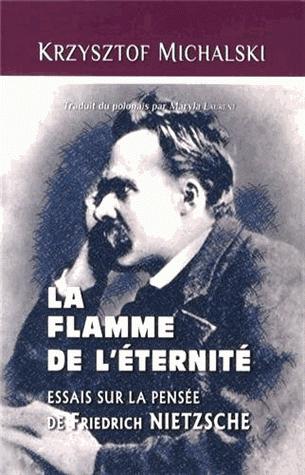 « La vie éternelle n’est pas une autre vie, mais, précisément, la vie que tu vis » écrivait le philosophe de Sils-Maria. La question de l’éternité est au cœur de la pensée de Nietzsche. Aimer la vie longue est selon lui le contraire d’aimer la vie. L’homme ne se résigne pas à la brièveté. L’homme est malade du manque d’éternité. Pour Nietzsche c’est la cause du nihilisme. L’éternité est pourtant à portée de main. Elle est dans le corps même, ce grand oublié, elle est dans la vie même. C’est la vie elle-même qui crée les valeurs qui rendent inutile le nihilisme. La tentation du nihilisme est inhérente à la vie elle-même mais c’est la vie qui permet de la surmonter. « Nous ne pouvons comprendre que le monde que nous avons créé » explique Nietzsche. Il rejette ainsi toute foi et toutes valeurs extérieures à l’homme. Le principe d’une foi extérieure à l’homme est de refuser le temps cyclique, comme le faisait Augustin d’Hippone. Le monothéisme veut le temps droit et linéaire. Au contraire, Nietzsche affirme que « tout ce qui est droit ment (…), toute vérité est courbée, le temps lui-même est un cercle. » (Zarathoustra). C’était ce qu’exprimait Héraclite : « Pour le temps comme sur le pourtour de la roue, le début et la fin sont communs ».
« La vie éternelle n’est pas une autre vie, mais, précisément, la vie que tu vis » écrivait le philosophe de Sils-Maria. La question de l’éternité est au cœur de la pensée de Nietzsche. Aimer la vie longue est selon lui le contraire d’aimer la vie. L’homme ne se résigne pas à la brièveté. L’homme est malade du manque d’éternité. Pour Nietzsche c’est la cause du nihilisme. L’éternité est pourtant à portée de main. Elle est dans le corps même, ce grand oublié, elle est dans la vie même. C’est la vie elle-même qui crée les valeurs qui rendent inutile le nihilisme. La tentation du nihilisme est inhérente à la vie elle-même mais c’est la vie qui permet de la surmonter. « Nous ne pouvons comprendre que le monde que nous avons créé » explique Nietzsche. Il rejette ainsi toute foi et toutes valeurs extérieures à l’homme. Le principe d’une foi extérieure à l’homme est de refuser le temps cyclique, comme le faisait Augustin d’Hippone. Le monothéisme veut le temps droit et linéaire. Au contraire, Nietzsche affirme que « tout ce qui est droit ment (…), toute vérité est courbée, le temps lui-même est un cercle. » (Zarathoustra). C’était ce qu’exprimait Héraclite : « Pour le temps comme sur le pourtour de la roue, le début et la fin sont communs ».
00:05 Publié dans Livre, Livre, Philosophie | Lien permanent | Commentaires (0) | Tags : philosophie, nietzsche |  |
|  del.icio.us |
del.icio.us |  |
|  Digg |
Digg | ![]() Facebook
Facebook
A Breviary for the Unvanquished
A Breviary for the Unvanquished
By Michael O'Meara
A propos of Dominique Venner
Un Samouraï d’Occident: Le Bréviaire des insoumis [2]
Paris: PGDR, 2013
 In his commentaries on the Gallic Wars, Julius Caesar claimed the ancient Celts were ruled by two principles: to fight well and to speak well. By this standard, the now famous essayist, historian, and former insurgent, Dominique Venner, who frequently identified with his Gallic ancestors, was the epitome of Caesar’s Celt—for with arms and eloquence, he fought a life-long war against the enemies of Europe.
In his commentaries on the Gallic Wars, Julius Caesar claimed the ancient Celts were ruled by two principles: to fight well and to speak well. By this standard, the now famous essayist, historian, and former insurgent, Dominique Venner, who frequently identified with his Gallic ancestors, was the epitome of Caesar’s Celt—for with arms and eloquence, he fought a life-long war against the enemies of Europe.
Like much else about him (especially his self-sacrifice on Notre Dame’s high altar, which, as Alain de Benoist writes, made him un personage de l’histoire de France), Venner’s posthumously published Un Samuraï d’Occident bears testament not just to his rebellion against the anti-European forces, but to his faith in the Continent’s tradition and the restorative powers this tradition holds out to a Europe threatened by the ethnocidal forces of the present American-centric system of global usury.
His “samurai” (his model of resistance and rebellion) refers to the “figure” of the aristocratic warrior, once honored in Japan and Europe. Such a figure has, actually, a long genealogy in the West, having appeared 30 centuries ago in Homer’s epic poems. And like a re-occurring theme, this figure continued to animate much of Western life and thought—up until at least 1945.
An especially emblematic illustration of Venner’s warrior is Albrect Dürer’s 1513 engraving of “The Knight, Death, and the Devil.” In the daunting Gothic forest sketched by Dürer, where his solitary knight encounters both the devil and time’s relentless march toward death, the figure of the noble warrior is seen serenely mounted on his proud horse, with a Stoic’s ironic smile on his lips, as he patrols the lurking dangers, accompanied by his dog representing truth and loyalty.
For Venner, Dürer’s timeless rebel does what needs doing, knowing that however high the price he must pay to defend the cosmic order of his world, it will be commensurate with whatever “excellence” (courage and nobility) he finds in himself. It is, in fact, the intensity, beauty, and grandeur of the knight, in his struggle with the forces of death and disorder, that imbue him with meaning. The crueler the destiny, it follows, the greater it is—just as a work of art is great to the degree it transcends tragedy by turning it into a work of beauty.
Contemporary “conservatives” and libertarians struggling with the crisis-ridden economic imperatives of our globalized/miscegenated consumer society, will undoubtedly think Venner’s warrior irrelevant to the great challenges facing it—but this is not the opinion of the “European Resistance” (and it will not likely be the opinion of the European-American Resistance, if one should arise). For between those forming the fake, system-friendly opposition to the liberal nihilism programming our global electronic Gulag—and those European rebels defending the Continent’s millennial tradition and identity—there stretches a gaping ontological abyss.
***
Venner’s book begins with an account of a not uncommon situation in today’s France, especially among the so-called petit blancs—the little people. He cites the case, reported by Le Monde, of one “Catherine C.,” who is what France’s black and brown invaders refer to as a Gauloise: a French native (i.e., someone whose Celtic ancestors fought Caesar’s legions).
All her life Catherine C. has lived in the suburbs of Paris, in a housing estate originally designed to lodge French workers, but now occupied almost exclusively by the invaders. She has hence become a “minority,” a stranger in her own land, abandoned to the whim and rule of the non-Europeans dominating her environment. As such, she rarely leaves her apartment, feeling alienated not just from her “neighbors,” but from the established institutions and authorities favoring the invaders. Even her son, who lacks her sense of French identity, has converted to Islam and wants “to be black or beur [Arab] like everyone else.” But however isolated and threatened, this Gauloise refuses—out of pride—to abandon her home or identity.
We know from other sources that Venner’s resistance to the present anti-white regime began long ago, in his late adolescence, when he took up arms to defend “French Algeria.” His resistance – then on the field of battle (against the outer enemy), later in Parisian street skirmishes (against the inner traitor), and finally on the printed page – has shaped the course of his entire life. Though a “tribal solidarity” and “rebel heart” motivated his initial resistance, the cause of France’s “little people”—the Catherine C.’s—constituting the majority of the nation—became a no less prominent motive for him, especially in that the “little people” of French France are the principal victims of the elites’ criminal system of governance and privilege.
***
“To exist,” Venner argues, “is to struggle against that which denies me.” Since 1945, the whole world has “denied” the European (allegedly “responsible” for the Shoah, slavery, colonization, etc.) the right to exist. At the most fundamental level, this implies that Europeans have no right to an identity: no right to be who they are (given that they are a scourge to humanity). Venner, of course, refused to submit to such tyranny, which has made him a “rebel”: someone who not only refuses to accommodate the reigning subversion, but who remains true to himself in the name of certain higher principles.
Venner’s rebel—the “unvanquished” to use Faulkner’s term—is an offspring of indignation. In face of imposture or sacrilege, the rebel revolts against a violated legitimacy. His rebellion begins accordingly in the conscience before it occurs in arms. Our earliest example of such a rebellion is Sophocles’ Antigone, who rebelled against King Creon’s violation of the sacred law. Like Antigone, Venner’s rebel warrior obeys a transcendent “legitimacy” and resists all that transgresses it; similarly, he never calculates the prospect of success or refuses to pay the often terrible price of rebellion—because a higher defining duty with which he identifies impels him to do so.
Since such rebellion arises from an offended spirit, it often breaks out where least expected. In a life spanning the 20th century’s great catastrophes (World War II, the German Occupation of France, the so-called “Liberation” and its murderous left-wing purges, the Cold War, Decolonization, etc.), Venner has known a Europe paralyzed by dormition (sleep)—too traumatized by the great bloodlettings and destructions of earlier decades to counter her ongoing de-Europeanization. The present “shock of history,” he contends, may change this.
A historical figure (in the form of a revolutionary opponent of De Gaulle’s Fifth Republic, then as a founder of the European New Right, and finally as a proponent of a “revolutionary nationalist” Europe) before he became a historian, Venner holds that there are no fatalities in history (“the trace men leave on their destiny”) and that Europeans, with their incomparable legacy, will eventually awake to resume their destiny. Their history and tradition weighs thus in their favor.
In the last year of his life, Venner thought the forces of French indignation had finally begun to stir. The massive, spontaneous upsurge of outraged opinion in early 2013 against the Taubira Law legalizing homosexual marriage had set it off. (What was so unexpected in this was that earlier, “Catholic” Spain had passed a similar law without mass protest.) Everywhere in French France, however, this perverted law was experienced as the last straw, for in denaturalizing the family it assaulted the very foundation of Continental life.
***
When a régime contemptuous of popular opinion provokes a “rebellion of the mothers,” as François Hollande’s Socialist/African government had, Venner thought it sign that an unpardonable transgression had occurred. For once middle-class Catholic house wives, with their children and strollers, joined militant identitarians and other rebels, in pouring onto French streets in unprecedented numbers to protest the Soviet-style desecrations, it was if another age had suddenly dawn— sign, perhaps, that the awakening had commenced.
Venner also reminds us that the founding work of European civilization, Homer’s Iliad, is all about what happens when the marriage law is violated. Though Homer believed a civilization could not exist in face of such violation, today’s elites know better—which suggests not just the advanced degree of decay among the latter, but the future-significance of the former.
The young identitarian and revolutionary nationalist rebels, who share Venner’s faith in the ongoing significance of the European tradition and follow him in resisting the violators, are the ones in whose hands the Continent’s future now lies—if Europeans are to have a future. The course of history in any case remains endless and open-ended: which means that the sons and daughters of Odysseus and Penelope, however denied they have become, may one day get another chance to re-conquer their lands and lives.
Venner’s last work (and he was always conscious that words are arms) addresses these awakening forces of resistance—preeminently those opposing the denaturalization of the nation (la Grande Replacement)—for the “prayers and hymns” of his breviary revere an alternative to liberal nihilism that re-grounds Europeans in themselves and in their unique heritage.
***
This European heritage is key to everything, for a people or civilization lacking a memory of its past and a stake in its continuation, is a people or civilization that no longer exists as such. Contrary to the tabula rasa suppositions of the moneychangers, Europeans were not born yesterday. Whatever future they have is unlikely to come from the deranged utopias planned for them, but rather from the memory of their past—and thus from the recognition of who they are in this period and of what is expected of them. Faithful to Europe, Venner’s rebel warrior fights for a future he sees sanctioned in everything that has gone before.
The hubristic course of the 20th century—with its great civil wars and wanton destruction, its world crusades and diseased, mercantile, technological metaphysics—has created a situation in which for the first time in history the Continent’s peoples have been denied their tradition (the soul of their culture) and compelled to find themselves in everything alien to who they are. As a historian and as one of Nietzsche’s “good Europeans,” Venner’s life work might be characterized as a struggle to recover Europe’s memory and the relevance of her sacred wisdom.
If Europeans, then, are to escape the great abyss of nothingness the money powers in Washington and New York plan for them, they will need to recover their identity as a people and a civilization. This means returning (not literally, but spiritually) to their roots, to those authentic sources that created them at the beginning of their history, distinguished their destiny from others, and sustained them over the millennia.
There is, as such, nothing antiquarian or nostalgic in this privileging of history’s longue durée, for the tradition and culture animating a people’s millennial history are ultimately never things of the past per se, but of the future—given that the aesthetic values and living spirituality inherent in them nourish the Europeans’ representations, structure their behavior, and lend meaning to their endeavors.
***
Venner claims the preeminent source for the spiritual re-conquest of Europe’s identity (given that the Catholic Church has abandoned its European roots for the sake of becoming a truly universal religion) is Homer, for his sacred poems reveal the “secret permanences” distinct to the Continent’s family of closely related nations and peoples. Though written at the dawn of our civilization, there is nothing in the Homerian epics that is not intimately familiar to the European of today. For in giving form to the European soul, Homer articulated a conception of the world that is entirely unique to the West—a conception, as Georges Dumézil demonstrated, that was rooted in the earlier Indo-European or Borean antecedents of pre-Hellenic Europe, and one that would shape the subsequently Latin, Celtic, Slavic, and Germanic expressions of European life. In Homer, the true European encounters a mirror of his soul.
Virtually every figure and sentiment distinct to European man is to be found in the civilization-creating monuments of the blind poet—for his epics articulated archetypes that will always be timeless and timely for “the white men of the West.” This seems especially the case in respect to Homer’s model of life, which makes “nature the base, excellence the goal, and beauty the horizon.” Above all, Homer’s virile concept of the warrior and his affirmation of the European tradition (which never actually changes, only adapts) offer Europeans the sole alternative to their impending extinction.
***
Those acquainted with Venner’s vast opus will find Un Samuraï d’Occident an eloquent summation of his identitarian postulates. Those unfamiliar with it may find a door opening to an entirely different future. Finally, for Venner’s fellow rebels—the unvanquished—his breviary is certain to impart new vigor to the hours and offices of their already endless sacrifices to remain true to themselves.
More on Dominique Venner
• “The Rebel [3]”
• “From Nihilism to Tradition [4]”
• “The Foundations of the 21st Century [5]”
• “Another European Destiny [6]”
• “The Shock of History [7]”
• “Arms and Being [8]”
Source: http://www.wermodandwermod.com/newsitems/news310820131249.html [9]
Article printed from Counter-Currents Publishing: http://www.counter-currents.com
URL to article: http://www.counter-currents.com/2013/08/a-breviary-for-the-unvanquished/
URLs in this post:
[1] Image: http://www.counter-currents.com/wp-content/uploads/2013/08/Venner-Dominique-Un-samourai-dOccident.jpg
[2] Un Samouraï d’Occident: Le Bréviaire des insoumis: http://www.amazon.fr/Un-samoura%C3%AF-dOccident-br%C3%A9viaire-insoumis/dp/2363710738
[3] The Rebel: http://www.counter-currents.com/2010/06/the-rebel/
[4] From Nihilism to Tradition: http://www.counter-currents.com/2010/06/from-nihilism-to-tradition/
[5] The Foundations of the 21st Century: http://www.counter-currents.com/2010/06/foundations-of-the-twenty-first-century/
[6] Another European Destiny: http://www.counter-currents.com/2010/06/another-european-destiny/
[7] The Shock of History: http://www.counter-currents.com/2011/11/the-shock-of-history/
[8] Arms and Being: http://www.counter-currents.com/2013/07/arms-and-being/
[9] http://www.wermodandwermod.com/newsitems/news310820131249.html: http://www.wermodandwermod.com/newsitems/news310820131249.html
00:05 Publié dans Livre, Livre, Nouvelle Droite | Lien permanent | Commentaires (0) | Tags : dominique venner, nouvelle droite, livre |  |
|  del.icio.us |
del.icio.us |  |
|  Digg |
Digg | ![]() Facebook
Facebook
jeudi, 05 septembre 2013
Intellectuels sous l'occupation
INTELLECTUELS SOUS L’OCCUPATION
Pierre Le Vigan
Ex: http://metamag.fr
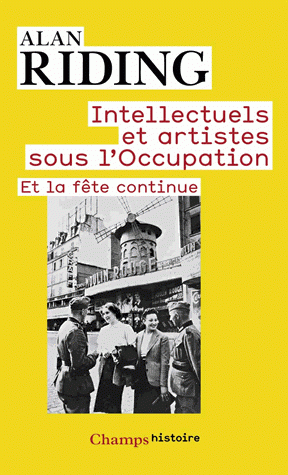 Le premier mérite de l’auteur, journaliste américain installé de longue date en France, c’est qu’il évite d’aborder une période compliquée avec des idées simples. Peu de périodes furent aussi compliquées que celle de l’Occupation. Alan Riding pose les bonnes questions : « Est-ce que le fait d’avoir travaillé sous l’Occupation était systématiquement une forme de collaboration ? » Des questions cruciales pour les intellectuels et artistes.
Le premier mérite de l’auteur, journaliste américain installé de longue date en France, c’est qu’il évite d’aborder une période compliquée avec des idées simples. Peu de périodes furent aussi compliquées que celle de l’Occupation. Alan Riding pose les bonnes questions : « Est-ce que le fait d’avoir travaillé sous l’Occupation était systématiquement une forme de collaboration ? » Des questions cruciales pour les intellectuels et artistes.
00:05 Publié dans Histoire, Littérature, Livre, Livre | Lien permanent | Commentaires (0) | Tags : intellectuels, livre, occupation, occupation allemande, deuxième guerre mondiale, seconde guerre mondiale, france, lettres françaises, littérature française, lettres, littérature, histoire, histoire littéraire |  |
|  del.icio.us |
del.icio.us |  |
|  Digg |
Digg | ![]() Facebook
Facebook
mardi, 03 septembre 2013
L’idéologie du genre, une dérive du féminisme

L’idéologie du genre, une dérive du féminisme
Ex: http://www.lebreviairedespatriotes.fr
Quelle est donc cette idéologie que la Manif pour Tous entend contrer dès la rentrée ? L’idéologie du genre. Comment est-elle parvenue en France ? Quel est son but ? Ses conséquences sur l’éducation des enfants ?
 Dans son livre, Le féminisme et ses dérives, rendre un père à l’enfant-roi, le professeur d’histoire-géographie et ancien féministe Jean Gabard nous explique comment et pourquoi notre société en est arrivée là. Il ne nous donne pas de recette miracle mais il nous explique que deux idéolog
Dans son livre, Le féminisme et ses dérives, rendre un père à l’enfant-roi, le professeur d’histoire-géographie et ancien féministe Jean Gabard nous explique comment et pourquoi notre société en est arrivée là. Il ne nous donne pas de recette miracle mais il nous explique que deux idéolog
ies s’affrontent et s’entretiennent mutuellement. L’une, visant à nier toute différence entre l’homme et la femme. L’autre voulant au contraire ramener l’homme à son autorité pour faire tenir à carreaux les enfants qui sont mal élevés. Dans une première partie, nous verrons les rapports entre l’homme et la femme tout au long de l’histoire. Dans une seconde partie, nous verrons les conséquences de l’idéologie du genre dans notre société.
Au cours de l’histoire, les rapports entre l’homme et la femme se sont modifiés. Durant la préhistoire, la femme était sacralisée parce que l’homme s’était rendu compte qu’elle pouvait donner la vie. Dans l’Antiquité, la femme avait un rôle ambigu. Elle avait moins de droits que les hommes mais pouvait prendre des initiatives dans la maisonnée. En outre, certains cultes étaient rendus à des déesses. Certaines fêtes étaient même réservées aux femmes et l’homme qui osait s’y introduire était puni, la sentence allant jusqu’à la mort.
La femme avait un statut entre valorisation et dévalorisation. Il faut bien comprendre que la femme s’occupait du domaine privé et que l’homme s’occupait du domaine public. La seule personne qui est venue mettre le bazar dans ce monde est le Christ. Il est le seul à parler d’égalité entre l’homme et la femme. Petit à petit, au Moyen Âge, les rapports entre l’homme et la femme se sont modifiés. Certes, la femme restait à la maison pendant que l’homme allait travailler à la ferme. Mais dans les seigneuries, elle les accompagnait et pouvait même prendre des initiatives dans le château. Exemple, à partir de 987, les privilèges étaient devenus héréditaires par la volonté d’Hugues Capet.
Aussi, lorsque le seigneur décidait de donner, de louer ou de vendre son bien, la famille était donc conviée à donner son avis sur le sujet. La femme était présente. Toutefois, malgré ce rôle et ce statut, une contestation intellectuelle se mis en place lors du siècle des Lumières. Pourtant, on peut remarquer que ce n’est pas dans un cadre trop flatteur. La contestation est surtout venue de mai 1968. Cette contestation s’inspire des études sur le genre qui sont publiées pour la première fois aux États-Unis. La polémique arrive en France en 2011, lorsque le ministre de l’éducation national, Luc Châtel demande à faire la distinction entre l’identité sexuelle et l’orientation sexuelle dans les programmes de SVT.
Les conséquences de cette idéologie sont doubles. Soyons clairs : les études sur le genre sont nécessaires pour comprendre les rapports entre l’homme et la femme et démonter certains préjugés. Le problème est la théorisation de ces études par certains chercheurs. Ils sont ensuite passés dans les institutions internationales pour les imposer (ONU, UE). La conséquence est d’abord juridique. Dans la loi, il n’y a plus de distinction entre l’homme et la femme. La seule exception est le sous-marin : la femme n’a pas le droit d’y aller.
Ensuite sur l’éducation des enfants : l’enfant ne connait plus de limite, il a beaucoup de mal avec les règles de disciplines, de grammaire, de calculs, de conjugaison d’orthographes. Pourquoi ? Parce qu’il n’y a plus de père et de mère. Le rôle de la mère est affectif auprès de l’enfant puisque c’est elle qui l’a porté jusqu’à sa naissance. Le rôle du père est de casser cette affection pour mettre des limites aux désirs de l’enfant.
L’exemple de l’interrupteur : vous avez souvent vu un enfant s’amuser avec un interrupteur pour allumer et éteindre la lumière. Normalement, le père doit intervenir pour demander à l’enfant d’arrêter de jouer avec la lumière. Mais si c’est la mère, alors l’enfant le prendra comme un chantage affectif : « j’obéis parce que sinon maman ne m’aimera plus ». Le temps que les parents se mettent d’accord sur le moment de l’intervention, l’enfant ne va pas s’arrêter.
En conclusion, pendant longtemps, on a utilisé les différences pour dire que l’homme domine la femme mais aujourd’hui on affirme que ces différences sont sexistes et discriminatoires. Par ailleurs tous les programmes de lutte contre la discrimination mis en place par les gouvernements ont échoué puisque les différences ressortent plus violemment au moment de la puberté. La question est de savoir si nous serons capables de construire une société à même d’accepter les différences et de se tenir à notre place.
Antoine Billot
00:06 Publié dans Livre, Livre, Sociologie | Lien permanent | Commentaires (0) | Tags : gender studies, théorie du genre, féminisme, sociologie, jean gabard |  |
|  del.icio.us |
del.icio.us |  |
|  Digg |
Digg | ![]() Facebook
Facebook
lundi, 02 septembre 2013
VILLON & CÉLINE de Pierre de BONNEVILLE
Vient de paraître : VILLON & CÉLINE de Pierre de BONNEVILLE
Quatrième de couverture
Villon et Céline : près de cinq siècles les séparent, mais ils ont beaucoup de points communs. Parmi ceux-ci, l’auteur a relevé l’identité, la personnalité, le milieu, le génie, l’invention, le parcours, le destin, la musique, le comique et le tragique. Dans un parallèle rigoureux, il nous trace ces ressemblances, qui sont l’occasion de replonger dans les citations, les textes de ces deux écrivains d’exception.
« Les études comparatistes ne sont plus guère à la mode. Le fait que notre auteur renoue avec cette tradition se justifie tant il est vrai que le parallèle entre l’œuvre et l’itinéraire respectifs de Villon et Céline apparaît ici comme une évidence. Se basant notamment sur la somme du grand médiéviste Pierre Champion, il passe en revue tout ce qui les réunit. Leur destin d’écrivain maudit bien sûr, mais surtout ce lyrisme basé sur l’émotion et les ressources du langage populaire » (Marc Laudelout).
00:05 Publié dans Littérature, Livre, Livre | Lien permanent | Commentaires (0) | Tags : livre, littérature, lettres, lettres françaises, littérature française, villon, céline, marc laudelout |  |
|  del.icio.us |
del.icio.us |  |
|  Digg |
Digg | ![]() Facebook
Facebook
vendredi, 30 août 2013
Reconquérir les rues, c'est l'affaire de tous!

Pierre Le Vigan
Ex: http://metamag.fr
« La forme d’une ville change plus vite hélas que le cœur d’un mortel » disait Baudelaire. La quasi disparition des rues dans de nombreuses banlieues en témoigne. Car les routes ne sont pas des rues.
La valeur ajoutée d’une rue est tout autre. Elle ne sert pas seulement à se déplacer mais à tisser des liens entre les riverains. C’est cette question du risque de disparition de la rue et de sa nécessaire reconquête qu’a exploré, en un livre aussi vivant qu’une suite de croquis de voyage, l’architecte Nicolas Soulier. « Pourquoi reconquérir les rues ? Parce que c’est là que se joue, sans que l’on en soit toujours conscient, une grande partie de la qualité de la vie dans une ville ou un village. »
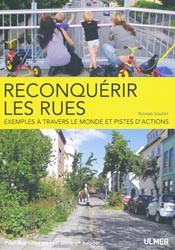 La rue n’est pas l’affaire des seuls urbanistes, c’est l’affaire de tous. La rue vivante est le signe d’une société en bonne santé, tandis que sa disparition, son remplacement par la route ou la « voie rapide » indique la maladie d’une société. Les exemples de Freiburg im Brisgau et des quartiers Vauban et Rieselfeld, mais aussi le quartier du Viertel à Brême, montrent qu’une ville plus ouverte aux usages sociaux de tous les âges, plus lente, plus humaine, est possible.
La rue n’est pas l’affaire des seuls urbanistes, c’est l’affaire de tous. La rue vivante est le signe d’une société en bonne santé, tandis que sa disparition, son remplacement par la route ou la « voie rapide » indique la maladie d’une société. Les exemples de Freiburg im Brisgau et des quartiers Vauban et Rieselfeld, mais aussi le quartier du Viertel à Brême, montrent qu’une ville plus ouverte aux usages sociaux de tous les âges, plus lente, plus humaine, est possible.
Cela consiste à rompre avec un certain culte de la vitesse, de l’accélération, à retrouver des échelles humaines de quelques 50 logements, bref, à rompre avec l’imaginaire du turbocapitalisme et de l’hypermodernité, pour chercher à restaurer une décence commune et même un courage civil de l’homme en ville à la place d’une société de la peur. La reconquête de la rue est ainsi au final une affaire très politique. Une affaire trop sérieuse pour la laisser aux aménageurs issus de quelque bureaucratie que ce soit.
Nicolas Soulier, Reconquérir les rues, exemples à travers le monde et pistes d’actions, pour des villes où l’on aimerait habiter, Ed Ulmer, 288 pages, 26 euros.
00:05 Publié dans Architecture/Urbanisme, Livre, Livre | Lien permanent | Commentaires (0) | Tags : architecture, urbanisme, nicolas soulier, ville |  |
|  del.icio.us |
del.icio.us |  |
|  Digg |
Digg | ![]() Facebook
Facebook
jeudi, 29 août 2013
Emilio Gentile: Pour ou contre César?
Emilio Gentile: Pour ou contre César?
Pierre Le Vigan
Ex: http://metamag.fr
 En 1938, le chanoine de Winchester écrivait que le totalitarisme, de droite ou de gauche, « c’est l’Antéchrist. C’est une révolution et une religion. » L’opposition entre le christianisme et le totalitarisme s’inscrit en fait à la suite d’une longue histoire. C’est le conflit entre religion et modernité.
En 1938, le chanoine de Winchester écrivait que le totalitarisme, de droite ou de gauche, « c’est l’Antéchrist. C’est une révolution et une religion. » L’opposition entre le christianisme et le totalitarisme s’inscrit en fait à la suite d’une longue histoire. C’est le conflit entre religion et modernité.
00:05 Publié dans Histoire, Livre, Livre | Lien permanent | Commentaires (0) | Tags : totalitarisme, religion, catholicisme, protestantisme, histoire, années 30, années 20, emilio gentile, allemagne, italie |  |
|  del.icio.us |
del.icio.us |  |
|  Digg |
Digg | ![]() Facebook
Facebook
dimanche, 25 août 2013
Manfred Spitzer zur digitalen Demenz
Sieben Stunden, vierzehn Minuten – Manfred Spitzer zur digitalen Demenz
Ellen Kositza
Ex: http://www.sezession.de
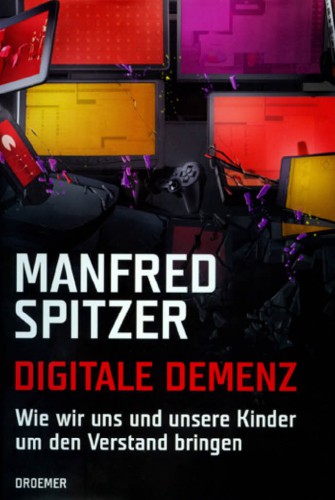 Das ist schon was: Mit Manfred Spitzers Warnung vor der »digitalen Demenz« hat ein Buch die obersten Ränge der Verkaufslisten gestürmt, das keinesfalls einen moderaten Ton anstimmt. Der bedeutende Hirnforscher lädt nicht zur Mäßigung vor der Glotze und an den Schaltknöpfchen der Spielautomaten ein. Er nennt keine empfehlenswerten Computerspiele, er beziffert keine Zeitzonen, innerhalb derer die Beschäftigung mit der virtuellen Welt tolerabel (oder gar günstig) wäre.
Das ist schon was: Mit Manfred Spitzers Warnung vor der »digitalen Demenz« hat ein Buch die obersten Ränge der Verkaufslisten gestürmt, das keinesfalls einen moderaten Ton anstimmt. Der bedeutende Hirnforscher lädt nicht zur Mäßigung vor der Glotze und an den Schaltknöpfchen der Spielautomaten ein. Er nennt keine empfehlenswerten Computerspiele, er beziffert keine Zeitzonen, innerhalb derer die Beschäftigung mit der virtuellen Welt tolerabel (oder gar günstig) wäre.
Nein, Spitzer, sechsfacher Vater, sagt ganz radikal: Jede vor dem Bildschirm der digitalen Medien verbrachte Stunde ist für Kinder vergeudete Lebenszeit. Der Psychiatrieprofessor argumentiert sprachlich bisweilen reichlich hemdsärmelig (was das Buch publikumsfreundlich macht), aber er hat die Wissenschaft auf seiner Seite.
Man will es kaum glauben: Sieben Stunden und vierzehn Minuten täglich verbringen deutsche Neuntkläßler im Durchschnitt vor dem Fernsehen, dem Video, dem Internet und vor Computerspielen. Die Mattscheibe des Smartphones ist dabei nicht mal einbezogen. Ungläubig rechnet man nach, zählt Wochenend- und Ferienzeiten hinzu und glaubt am Ende der Bilanz. Wohl keiner kann besser und glaubwürdiger erklären als Spitzer, was solche 50-Stunden-Wochen mit dem jugendlichen Gehirn machen. In vierzehn Kapiteln legt der Hirnforscher dar, inwiefern vorgeblich pädagogisch wertvolles Baby-TV, der Computer im Klassenzimmer, das Freizeitvergnügen in »sozialen Netzwerken« und auf welche Weise das sogenannte Multitasking, die Möglichkeit des »Abspeicherns« (also Auslagerns aus der aktiven Tätigkeit) und Ballerspiele die neuronalen Netzwerke beeinflussen. Das Gehirn ist ein plastisches, flexibles Organ, es verändert sich gemäß seiner Beanspruchung. Unter dem Dauerfeuer der Impulse bahnen sich »Trampelpfade« durch das Hirn, die relativ unveränderbar sind. Ein Jugendlicher, der seine Aktivitäten größtenteils ins »Netz« verlagert, anstatt durch Sport, Theater, papierne Lektüre oder Handwerk seinen Willen, seine Kreativität und Meinungsbildung zu schulen, wird ziemlich sicher seine affektive Selbstkontrolle einbüßen. Streßsymptome (wie Depressionen und Schlaflosigkeit), soziale Auffälligkeit und Schulprobleme stehen als sichere Folgen bevor. Spitzer malt keineswegs freihändig den Teufel an die Wand, er operiert mit einer Vielzahl wissenschaftlicher Studien und untermalt die Folgen der digitalen (Hyper-)Aktivität mit eigenen Graphiken, die den angeschlagenen Alarmton untermauern.
Bisweilen untergräbt Spitzers polternde, wenn auch meist sympathische Radikalität die Nachvollziehbarkeit: Daß die Google-Suche einen Nutzer, der auf dem gesuchten Gebiet bislang ahnungslos ist, ratlos zurücklasse, stimmt definitiv nicht. Susanne Gaschke hatte sich – ohne in ihren Schlußfolgerungen moderater zu sein – 2009 bereits gründlich und womöglich eloquenter mit digitalen Verdummungstendenzen auseinandergesetzt (Sezession 30/2009). Gaschkes vortreffliches Buch fehlt in Spitzers Literaturliste, dafür finden sich dort Verweise auf 28 Spitzersche Publikationen. Klar, der Mann ist vom Fach! Für Eltern, die ihre Kinder ohnehin vernünftig erziehen – also unter weitestgehender Umschiffung digitaler Ablenkmedien –, bietet das Buch vor allem eine Bestätigung und eine fundierte Argumentationsgrundlage. Die konkreten Tips zum adäquaten Hirntraining, die Spitzer bietet, mögen banal erscheinen, sind aber goldrichtig: Kleine Kinder profitieren von simplen Fingerspielen mehr als von Laptops im Kindergarten! Stete Übungen der Selbstkontrolle (erst ein Lied, auch wenn der Kuchen auf dem Tisch noch so lockt) dienen der Immunisierung gegen Streß! Singen Sie viel und laut!
Manfred Spitzer: Digitale Demenz. Wie wir uns und unsere Kinder um den Verstand bringen, München: Droemer 2012. 368 S., 19.99 €
Article printed from Sezession im Netz: http://www.sezession.de
URL to article: http://www.sezession.de/36727/sieben-stunden-vierzehn-minuten-manfred-spitzer-zur-digitalen-demenz.html
URLs in this post:
[1] Image: http://www.sezession.de/wp-content/uploads/2013/02/Manfred-Spitzer_Digitale-Demenz.jpg
00:05 Publié dans Livre, Livre, Psychologie/psychanalyse | Lien permanent | Commentaires (0) | Tags : manfred spitzer, livre, psychologie, psychiatrie, démence digitale |  |
|  del.icio.us |
del.icio.us |  |
|  Digg |
Digg | ![]() Facebook
Facebook
samedi, 24 août 2013
La France n’est pas un État de droit !
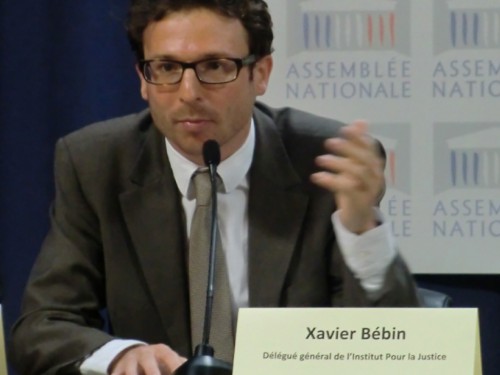
La France n’est pas un État de droit !
 J’ai publié, voici quelques années, un livre que j’avais rédigé avec des amis juristes. J’avais décidé de l’appeler « Avancer vers l’État de droit ».
J’ai publié, voici quelques années, un livre que j’avais rédigé avec des amis juristes. J’avais décidé de l’appeler « Avancer vers l’État de droit ».
J’avais choisi ce titre parce qu’il me semblait important de rappeler un fait flagrant et grave : la France n’était pas, et n’avait jamais été, un État de droit au sens strict du terme, c’est-à-dire un pays où les principes fondamentaux du droit sont considérés comme ayant été mis au jour, posés depuis là comme une garantie intangible, et respectés.
J’y soulignais la confusion du droit avec la loi qui est de mise dans ce pays depuis plus de deux siècles, et qui explique l’extrême instabilité institutionnelle qui prévaut depuis la Révolution française.
J’avais choisi ce titre aussi parce que j’avais à l’époque encore un mince espoir : pouvoir contribuer à ce que le pays avance, malgré tout, vers un fonctionnement d’État de droit. Depuis, j’ai perdu ce mince espoir. Ce, pour une raison simple : la régression s’est poursuivie et atteint aujourd’hui des proportions cataclysmiques.
Non seulement des droits fondamentaux, tels que le respect de la présomption d’innocence sont sans cesse bafoués, sous la forme des contrôles d’identité et des contrôles routiers incessants, mais les coupables dont il est avéré qu’ils sont coupables ne sont pas condamnés, ou très peu. L’idée, essentielle pour la justice, que le châtiment doit être proportionné par rapport au crime commun se trouve perdue : les condamnations à la perpétuité réelle n’existent pour ainsi dire plus, même pour les assassins récidivistes, et qu’une, deux, trois, cinq personnes de plus soient tuées ne change quasiment rien à la peine qui peut se trouver infligée.
Il existe des cas où un assassin jugé pour un premier assassinat et condamné à une lourde peine n’a pas vu sa peine aggravée lors d’un jugement pour un deuxième assassinat – tout simplement parce que la peine infligée lors du premier jugement était déjà la peine maximale.
On doit noter aussi que des milliers de peines de prison prononcées chaque année ne sont pas exécutées, parfois faute de place dans les prisons, parfois aussi parce que des peines de substitution sont proposées qui, souvent, sont l’équivalent d’une absence de peine.
On doit noter enfin que des peines pourront être décidées en fonction de la situation sociale du prévenu, ou du risque de troubles susceptibles de survenir en cas de condamnation : un chrétien appartenant à la classe moyenne sera plus aisément et plus lourdement condamné que, disons, un musulman venant d’un quartier dit « sensible » dont l’incarcération pourrait déboucher sur des émeutes, des incendies, des mises en état de siège de commissariats ou de quartiers entiers.
On doit ajouter que des pans entiers du système judiciaire sont aux mains d’organisations de gauche ou d’extrême gauche pour qui le criminel est avant tout une victime d’une société injuste et, dès lors, non coupable, ou quasiment non coupable par définition.
Nous en sommes à un stade où on doit dire que la France est un État de non-droit, un État qui, à la faillite économique, ajoute une dislocation sociale graduelle et le spectre d’une faillite morale.
Des livres viennent parfois rappeler cette faillite morale. C’était le cas, voici quelques mois, de « France Orange mécanique ».
C’est le cas aujourd’hui de « Quand la justice crée l’insécurité ». Le titre peut sembler excessif : il ne l’est pas. Le système juridique et judiciaire français crée effectivement l’insécurité, alors que son rôle devrait être inverse. Ce faisant, il contribue à la destruction de la liberté, car il n’est pas de liberté possible sans sécurité des biens et des personnes. Nous sommes tous dans une situation de liberté précaire et provisoire. Cela ne semble pas près de s’arranger.
L’auteur du livre, Xavier Bébin, est secrétaire général de l’Institut pour la justice. C’est un homme qui se bat. Je crains que son combat soit désespéré. Je n’en tiens pas moins à lui dire ici mon profond respect.
Xavier Bébin
Quand la justice
crée l’insécurité
Fayard
306 pages – 19 €
00:05 Publié dans Actualité, Affaires européennes, Droit / Constitutions, Livre, Livre | Lien permanent | Commentaires (0) | Tags : xavbier bébin, droit, france, europe, affaires européennes, politique internationale, livre |  |
|  del.icio.us |
del.icio.us |  |
|  Digg |
Digg | ![]() Facebook
Facebook
vendredi, 23 août 2013
Une digue au chaos ?...
Une digue au chaos ?...
Ex: http://metapoinfos.hautetfort.com
Les éditions suisses Cabédita viennent de publier Une digue au chaos - L'armée des citoyens, un essai de Jean-Jacques Langendorf et Mathias Tüscher. Une défense et illustration du modèle suisse de milice destinée en premier lieu à faire réfléchir les citoyens suisses avant un référendum qui les appellera à se prononcer sur le système de défense de leur pays, mais qui peut être utilement lue par tous les Européens intéressés par les questions de défense et de sécurité.
Spécialiste des questions de polémologie et de stratégie, Jean-Jacques Langendorf a récemment publié La pensée militaire prussienne (Economica, 2012).

" Le monde vit un tournant. Le désordre s’installe, qu’il soit social, économique, politique, sanitaire, climatique ou militaire... Les indicateurs se succèdent, tout aussi alarmants les uns que les autres.
Dans cet essai, les auteurs ne se contentent pas de réfléchir sur ces menaces et sur la manière de les contrecarrer, mais fournissent des exemples historiques démontrant la nécessité d’une armée enracinée dans la population, capable d’ériger Une digue au chaos...
Cette armée existe. Elle peut être requise en cas de catastrophe naturelle et de grave menace intérieure comme extérieure. Elle s’y prépare parfaitement, comme le prouvent ces propos du gouverneur militaire de Paris aux officiers l’accompagnant lors de la présentation d’un exercice exécuté par nos recrues: «Vous m’expliquerez comment ils font cela en quinze semaines avec des civils, alors que nous avons toutes les peines du monde à le faire avec des professionnels en un an?...»
Alors, voulons-nous vraiment sacrifier un instrument sécuritaire qui a contribué à la paix et la pérennité de la Suisse moderne?
En vue de la votation de septembre relative à l’obligation de servir, les auteurs lancent un cri d’alarme au sujet de la désécurisation de la Suisse à une période où les tensions sociales et internationales prennent l’ascenseur. "
11:20 Publié dans Défense, Livre, Militaria | Lien permanent | Commentaires (0) | Tags : livre, défense, armée, militaria, jean-jacques langendorf, suisse |  |
|  del.icio.us |
del.icio.us |  |
|  Digg |
Digg | ![]() Facebook
Facebook
lundi, 22 juillet 2013
CHARLES ROBIN ou "Le libéralisme comme volonté et comme représentation"

CHARLES ROBIN ou "Le libéralisme comme volonté et comme représentation"
Pierre Le ViganEx: http://metamag.fr
00:05 Publié dans Economie, Livre, Livre, Théorie politique | Lien permanent | Commentaires (0) | Tags : pierre le vigan, libéralisme, théorie politique, économie, politologie, sciences politiques, livre |  |
|  del.icio.us |
del.icio.us |  |
|  Digg |
Digg | ![]() Facebook
Facebook
samedi, 20 juillet 2013
L’Iran, de la “révolution blanche” à la révolution tout court
L’Iran, de la “révolution blanche” à la révolution tout court
 Janvier 1978-janvier 1979. C’est au moment où elle se modernisait que la monarchie des Pahlavi s’est défaite dans la confusion. De là date l’essor de l’islamisme radical.
Janvier 1978-janvier 1979. C’est au moment où elle se modernisait que la monarchie des Pahlavi s’est défaite dans la confusion. De là date l’essor de l’islamisme radical.
Une tasse de thé, un dernier regard, Mohammad Réza Pahlavi quitte son palais presque vide, le 16 janvier 1979. Dans les jardins, il retrouve la chahbanou, puis gagne l’aéroport international de Téhéran. Un petit groupe les attend, mais ni ambassadeur étranger ni ministre. Des militaires supplient le chah de rester. Le général Badreï, chef de l’armée de terre, s’agenouille selon un vieil usage tribal et lui baise les genoux. Le chah enlève ses lunettes, le relève. Il pleure en public. À Chapour Bakhtiar, nommé à la tête du gouvernement deux semaines plus tôt, le 31 décembre 1978, il dit : « Je vous confie l’Iran et vous remets entre les mains de Dieu. »
Le chah pilote lui-même son Boeing 707 jusqu’à la sortie de l’espace aérien iranien. Il craint une attaque surprise. Commence pour le souverain une longue errance. Rongé par un lymphome, repoussé par tous, il trouve asile en Égypte où il mourra le 27 juillet 1980. Il régnait depuis le 16 septembre 1941 et allait avoir 61 ans.
Moins de dix ans plus tôt, il avait célébré à Persépolis les 2 500 ans de l’Empire perse dont il se voulait le continuateur. En même temps, son régime exaltait la modernisation de l’Iran et la “révolution blanche”, ce plan ambitieux de réformes lancé en 1963. La “grande civilisation” à laquelle le chah avait rendu hommage semblait de retour.
Mais à quel prix ! Omniprésence de la Savak (la police politique), pouvoir autocratique, cassure entre la capitale et la province, fracture entre une élite occidentalisée et le peuple, autisme du chah qui ignore l’aspiration de la société à intervenir dans la vie politique, corruption, vénalité, et hausse des prix. À ceux qui évoquent les ravages sociaux et politiques de l’inflation, le chah répond : « Mon gouvernement m’assure du contraire. Vous ne répercutez que des bavardages de salon ! »
La “révolution blanche” a heurté les plus traditionalistes de la société iranienne, les chefs de tribus et une partie du clergé conduite par un mollah nommé Ruhollah Khomeiny. Né en 1902, celui-ci nie toute valeur au référendum qui doit approuver la “révolution blanche”. C’est surtout la proclamation de l’égalité entre homme et femme et la modernisation du système judiciaire qui le font réagir car il estime que ce sont deux atteintes aux préceptes de l’Islam et du Coran. Sans oublier que la réforme agraire est, dit-il, préparée par Israël pour transformer l’Iran en protectorat…
De Qom, ville sainte du chiisme, Khomeiny provoque le chah le 3 mai 1963. Il est arrêté. Suivent trois jours d’émeutes, les 15, 16 et 17 juin, 75 victimes, 400 arrestations et un constat : l’alliance “du rouge et du noir”, une minorité religieuse active et fanatisée avec les réseaux clandestins du Toudeh, le parti communiste iranien. Pour éviter la peine de mort à Khomeiny, des ayatollahs lui accordent le titre de docteur de la loi faisant de lui un ayatollah. Libéré, il récidive en 1964 et s’installe en Irak.
Ces oppositions, le chah les connaît. Elles le préoccupent. Il lance un appel aux intellectuels pour qu’ils en discutent en toute liberté. En avril 1973 se réunit le “Groupe d’études sur les problèmes iraniens”, composé de personnalités indépendantes. En juillet 1974, un rapport est remis au chah qui l’annote, puis le transmet à Amir Abbas Hoveida, son premier ministre. « Sire, lui répond-il, ces intellectuels n’ont rien trouvé de mieux pour gâcher vos vacances. N’y faites pas attention, ce sont des bavardages. » En fait, il s’agit d’un inventaire sans complaisance de l’état du pays complété de mesures correctives avec cet avertissement : si elles ne sont pas prises au plus vite, une crise très grave pourrait éclater. Cinq mois plus tard, le chef de l’état-major général des forces armées remet à son tour un rapport confidentiel et aussi alarmant que celui des intellectuels : l’armée résistera à une agression extérieure mais un grave malaise interne peut mettre en danger la sécurité nationale.
Ces deux avertissements venus du coeur même du régime restent lettre morte. Un nouveau parti officiel créé en 1975, un nouveau premier ministre nommé en août 1977 ne changent rien : les ministres valsent, les fonctionnaires cherchent un second emploi, le bazar de Téhéran gronde. Or dès l’année 1976, le chah sent que la maladie ronge son avenir. « Six à huit ans », lui a dit le professeur français Jean Bernard. C’est un homme fatigué qui affronte la montée de la violence révolutionnaire dans son pays.
D’Irak, Khomeiny redouble ses attaques. Le chah, dit-il, n’est qu’« un agent juif, un serpent américain dont la tête doit être écrasée avec une pierre ». Le 8 janvier 1978, un article paru dans un quotidien du soir de Téhéran fait l’effet d’une bombe. Il s’agit d’une réponse virulente à Khomeiny, qui a été visée au préalable par le ministre de l’Information. Or la polémique mêle vérités et mensonges. Le lendemain, à Qom, des manifestants envahissent la ville sainte : un mort, le premier de la révolution. Le 19 février, quarante jours après ce décès, le grand ayatollah Shariatmadari organise à Tabriz une réunion commémorative. À nouveau, du vandalisme, des morts, des blessés. L’engrenage manifestation-répression est engagé. Et à chaque quarantième jour, à Téhéran, à Tabriz, à Qom, se déroule une manifestation qui tourne à l’émeute. La police appréhende des jeunes gens rentrés récemment des États-Unis et connus pour leur appartenance à des groupes d’extrême gauche, ou des activistes sortis des camps palestiniens, des individus ne parlant que l’arabe. Les forces de l’ordre ne tentent quasi rien contre eux.
Le pouvoir s’affaiblit et s’enlise. Le chah nie la réalité, ignore le raidissement du clergé, continue à raisonner en termes de croissance de PIB. Et puis les Britanniques et les Américains ont leur propre vision de la situation ; ils conseillent de pratiquer une ouverture politique et de libéraliser le régime : le général Nassiri, cible de la presse internationale et qui dirigeait la Savak depuis 1965, est écarté en juin 1978. Loin de soutenir le chah, comme le faisait Richard Nixon, le président Carter envisage son départ et son remplacement. Au nom des droits de l’homme, les diplomates américains poussent aux dissidences les plus radicales. Une ceinture verte islamiste, pensent-ils, est plus apte à arrêter l’expansion du communisme soviétique.
Le 5 août 1978, le chah annonce des élections “libres à 100 %” pour juin 1979, une déclaration considérée comme un signe de faiblesse. Le 11, débute le ramadan. Des manifestations violentes éclatent à Ispahan : pour la première fois, des slogans visent directement le chah. Le 19, se produit un fait divers dramatique : un cinéma brûle, 417 morts. Un incendie criminel. L’auteur ? Des religieux radicaux ? La Savak ? Le soir même, la reine mère donne un dîner de gala. L’effet sur l’opinion est désastreux, alors que les indices orientent l’enquête vers l’entourage de Khomeiny.
Le nouveau premier ministre, Jafar Sharif- Emami, surnommé “Monsieur 5 %” tant il prélève de commissions, déclare sous le coup de l’émotion “la patrie en danger”. Le 7 septembre, 100 000 personnes manifestent à Téhéran avec des ayatollahs : des portraits de Khomeiny apparaissent. La loi martiale est décrétée pour le lendemain 8. Les manifestants prennent de vitesse police et armée. Ils veulent occuper la “maison de la Nation” et y proclamer une “République islamique”. Le service d’ordre tire en l’air, des tireurs embusqués ouvrent le feu sur la foule. C’est le “vendredi noir”, soigneusement « préparé et financé par l’étranger » affirment les auteurs. Au total, 191 victimes. La rupture entre le régime et les partisans de Khomeiny est totale.
Le chah est anéanti. « Jamais, confie-t-il, je ne ferai tirer sur mon peuple ! » Lui qui croyait être tant aimé se sent trahi : « Mais que leur ai-je donc fait ? ». Un seul souci l’habite : éviter la guerre civile, sa hantise. Le “vendredi noir” marque le début de son inexorable chute.
Le désordre et l’anarchie s’installent ; Khomeiny gagne la France, reçoit intellectuels et journalistes (mais pas ceux de Valeurs actuelles à qui les auteurs de l’ouvrage que nous citons en référence rendent hommage) qui raffolent de l’ermite de Neauphle-le-Château ; en Iran, les marches en sa faveur se multiplient et façonnent l’image d’une révolution romantique et démocratique ; les Américains organisent en secret la phase finale de leur plan : neutraliser l’armée iranienne et le haut état-major fidèles au chah. Les jeux sont faits.
« L’Iran des Pahlavi n’était certes pas parfait, mais il était en pleine modernisation, écrira Maurice Druon dans le Figaro du 12 novembre 2004. Fallait-il pousser à le remplacer par un régime arriéré, animé par un fanatisme aveugle ? L’essor de l’islamisme radical date de là. »
À lire Mohammad Réza Pahlavi. Le Dernier Shah/ 1919-1980, de Houchang Nahavandi et Yves Bomati, Perrin, 622 pages, 27 €.
00:05 Publié dans Histoire, Livre, Livre | Lien permanent | Commentaires (0) | Tags : histoire, politique internationale, iran, moyen orient, shah, shah d'iran, révolution islamiste, livre, houchang nahavandi |  |
|  del.icio.us |
del.icio.us |  |
|  Digg |
Digg | ![]() Facebook
Facebook







